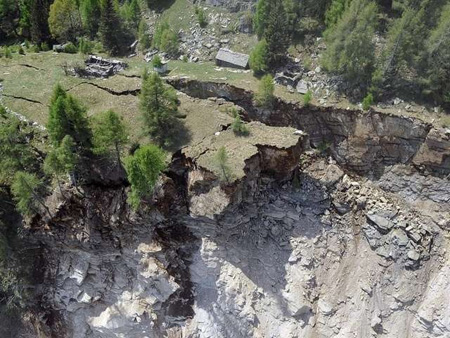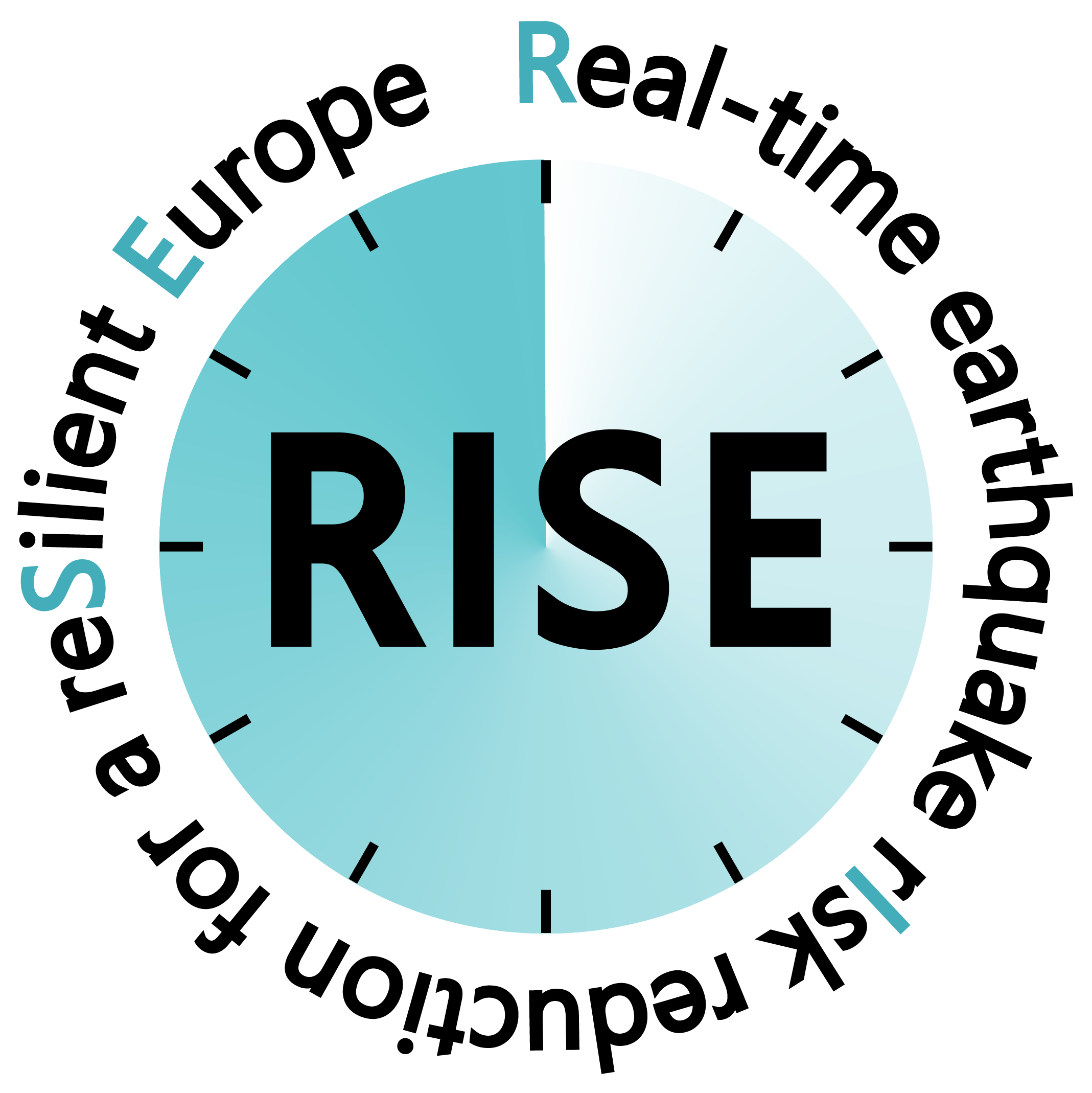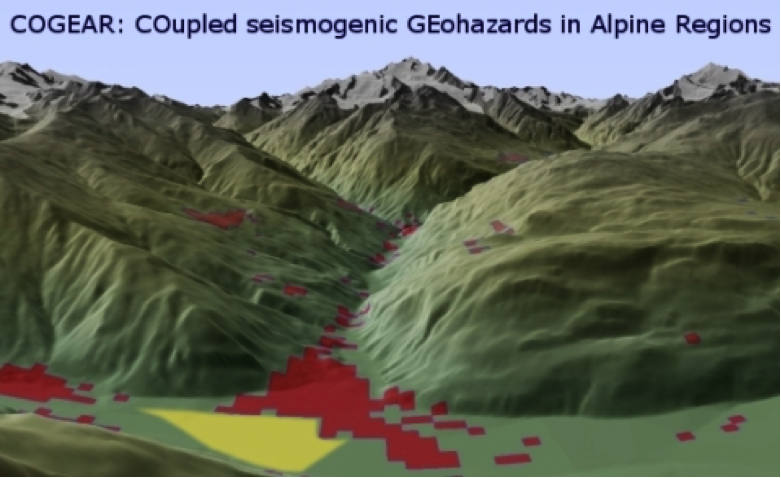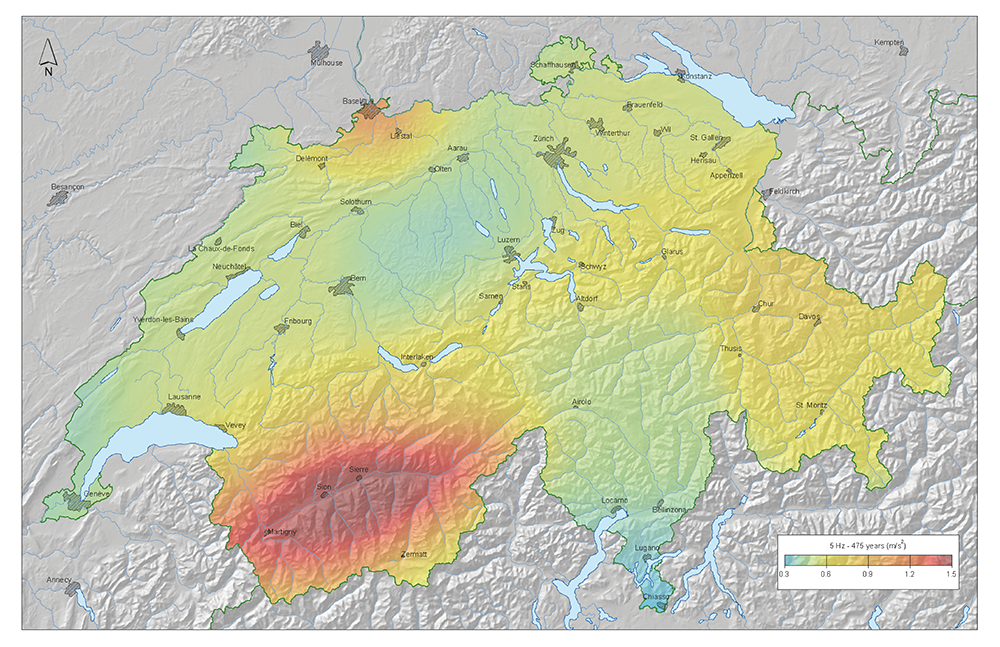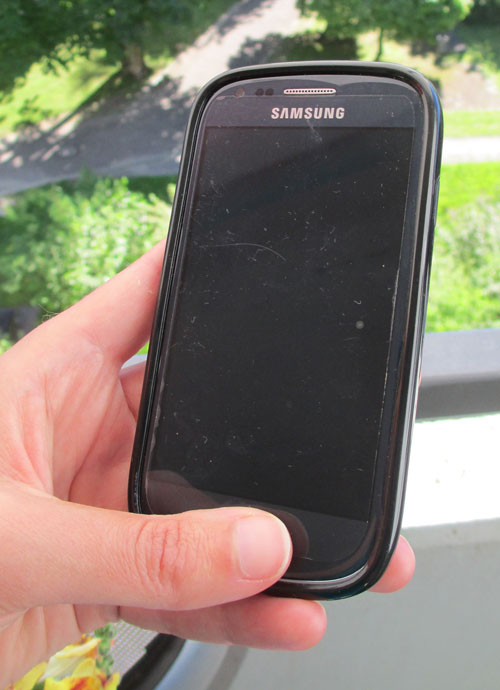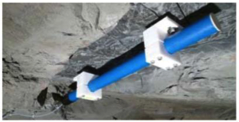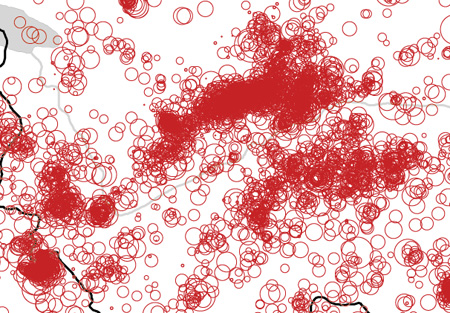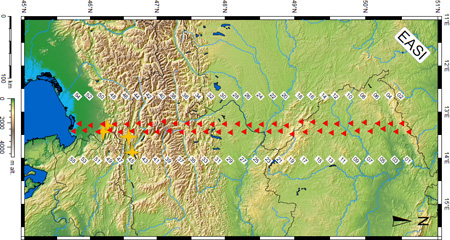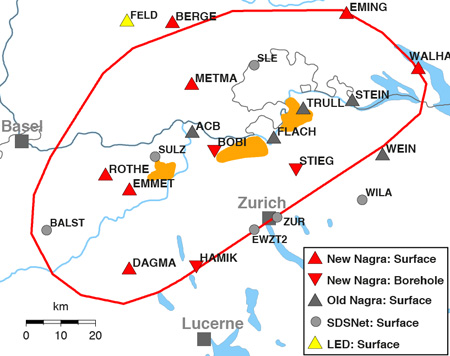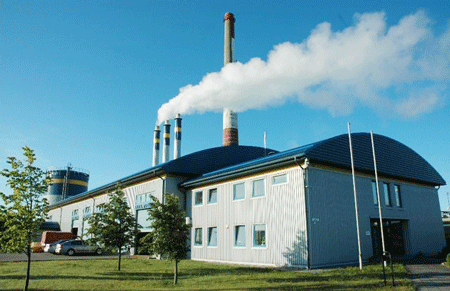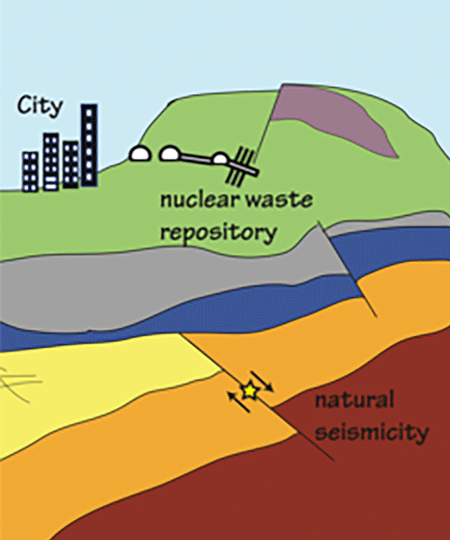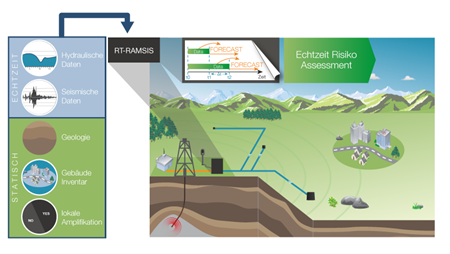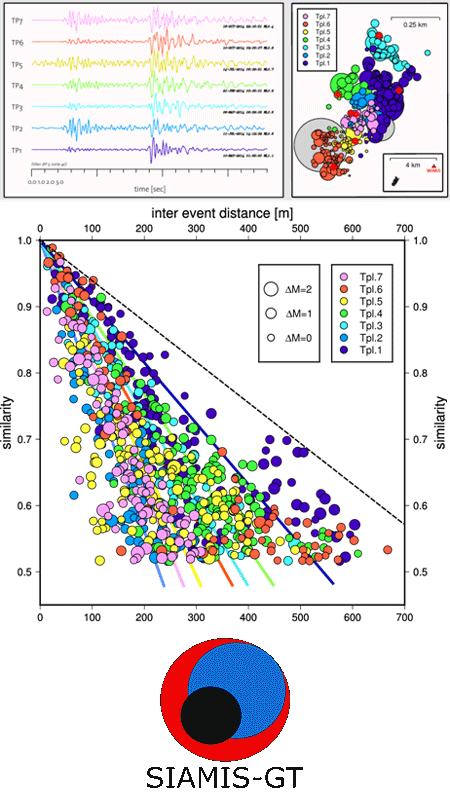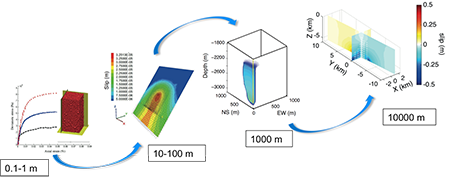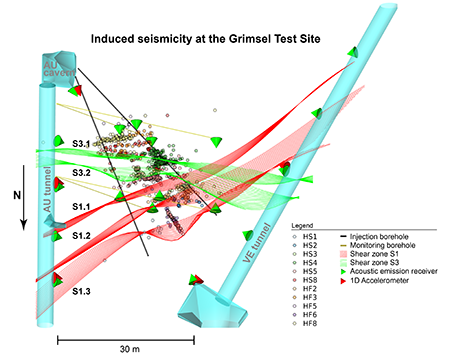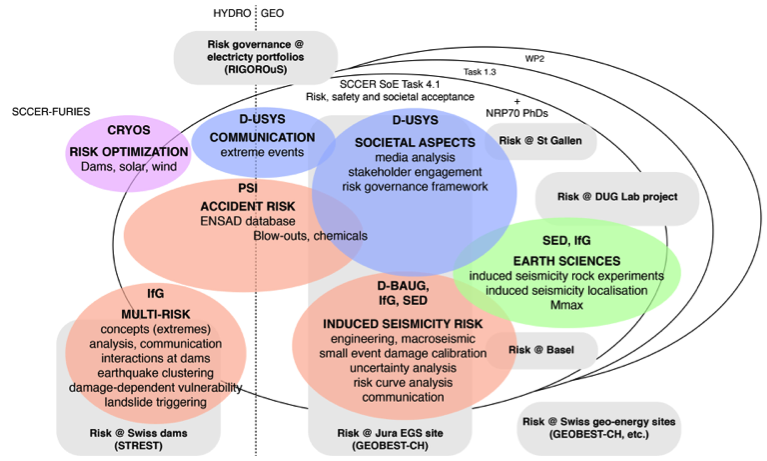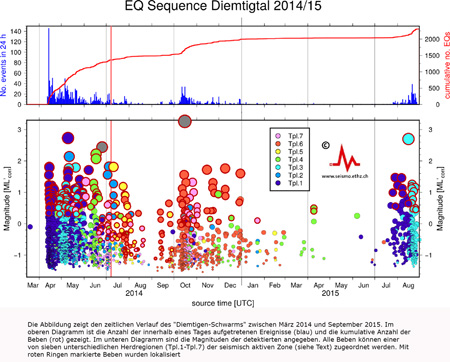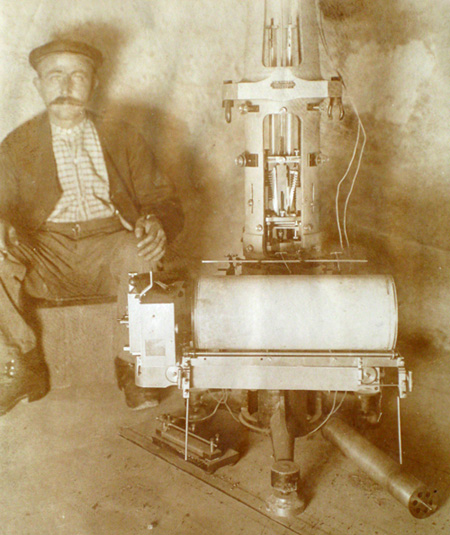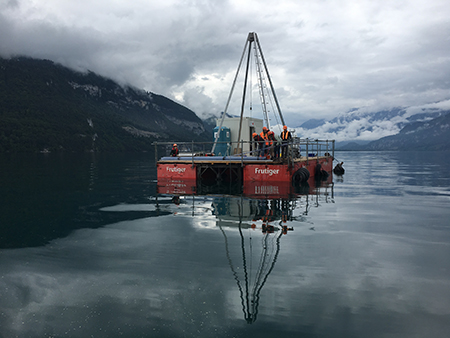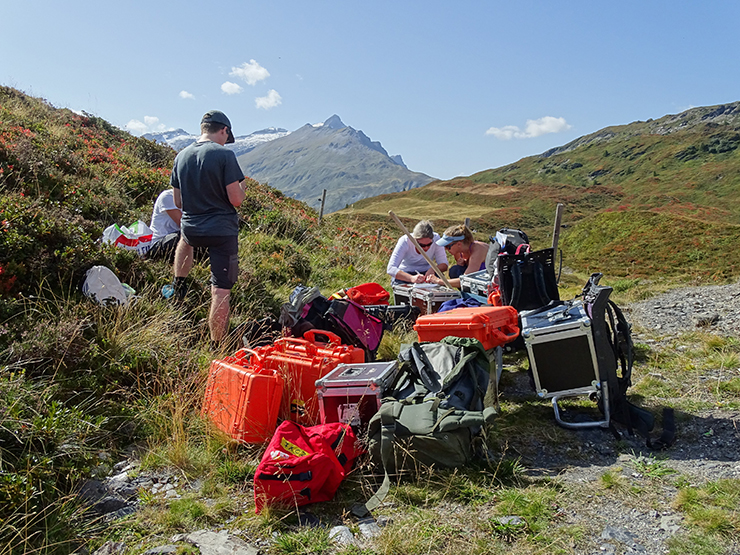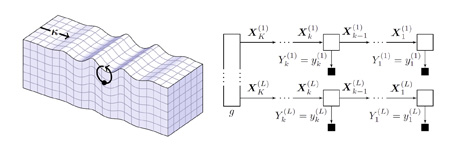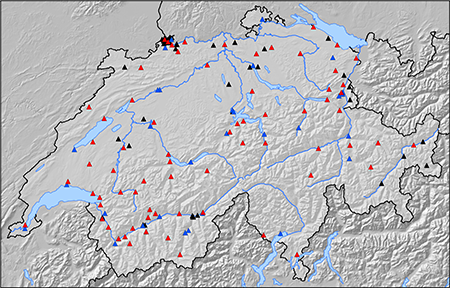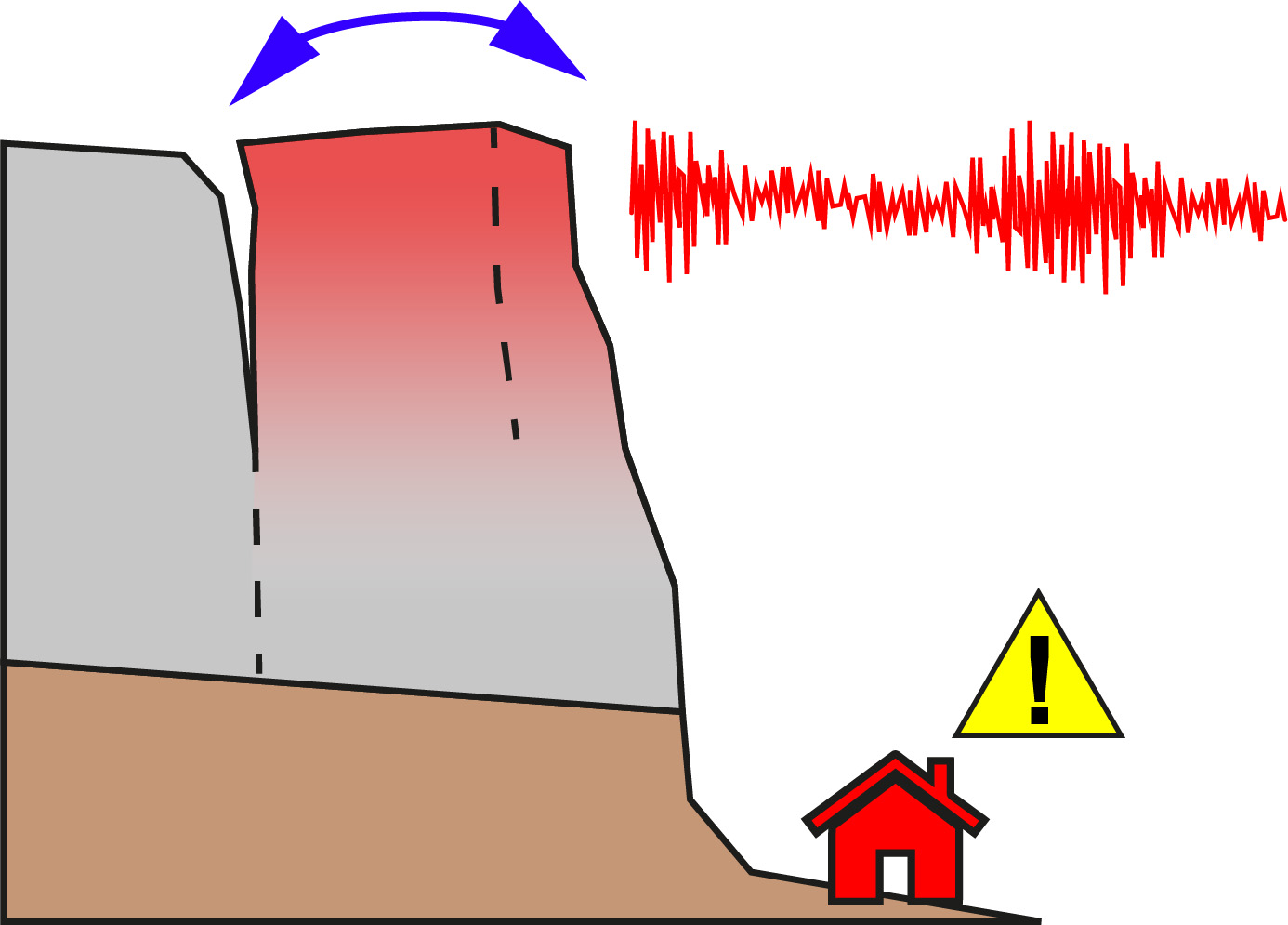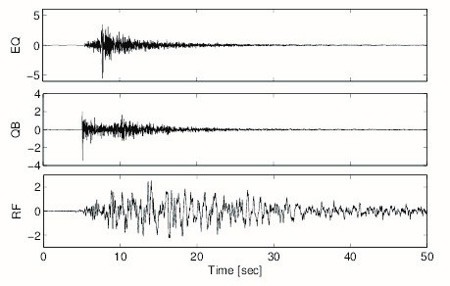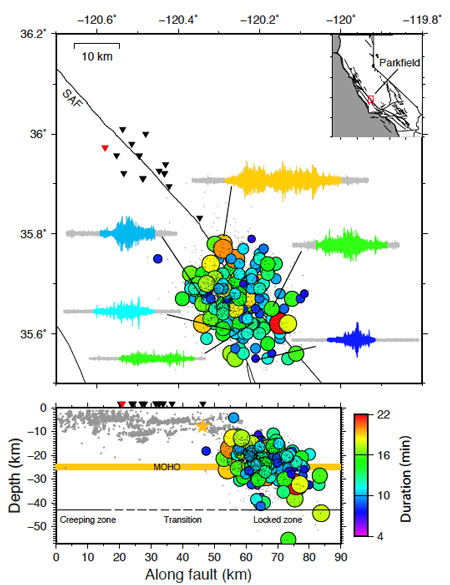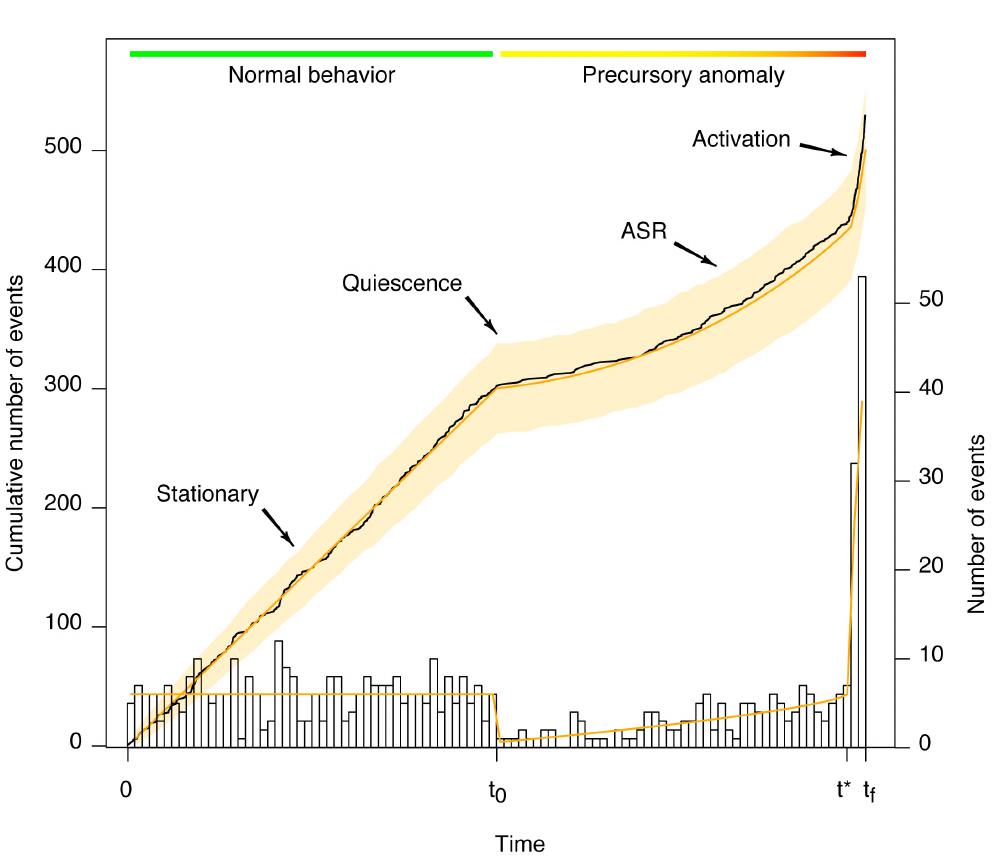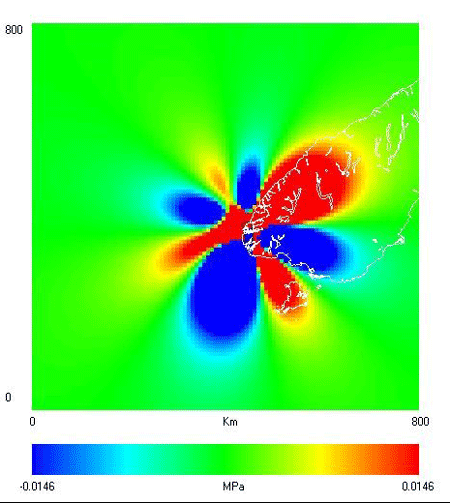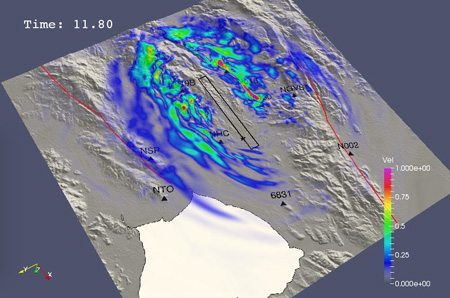Progetti conclusi
In questa pagina troverete una selezione di progetti già conclusi, che i collaboratori del Servizio Sismico Svizzero (SED) hanno gestito in veste di capofila o ai quali sono collaborati rivestendo un ruolo centrale. Non si tratta di una lista esaustiva, ma solo di una selezione di progetti centrali e di ampia portata. I progetti sono ordinati in base al loro campo di ricerca principale.
Progetti interdisciplinari
Characterization of Unstable Rock Slopes Through Passive Seismic Measurements
ENVRIplus: Environmental Research Infrastructures Providing Shared Solutions for Science and Society
ENVRIplus is a Horizon 2020 project bringing together Environmental and Earth System Research Infrastructures, projects and networks as well as technical specialist partners to create a more coherent, interdisciplinary and interoperable cluster of Environmental Research Infrastructures across Europe. The project has 37 partners from 13 countries, representing 27 European Research Infrastructures. Environmental Research Infrastructures provide key tools and instruments for researchers to address specific challenges within their own scientific fields. However, to tackle the grand challenges facing human society (for example climate change, extreme events, loss of biodiversity, etc.), scientific collaboration across the traditional fields is necessary. The Earth system is highly interlinked and the area of focus for environmental research is therefore our whole planet. Collaboration within ENVRIplus will enable multidisciplinary Earth system science across the traditional scientific fields, which is so important in order to address today’s global challenges. The cooperation will avoid the fragmentation and duplication of efforts, making the Research Infrastructures’ products and solutions easier to use with each other, improving their innovation potential and the cost/benefit ratio of the Research Infrastructure operations. ENVRIplus is organized in 6 overarching themes. SED leads the workpackage 'A Framework for Environmental Literacy' in Theme 4 'Societal Relevance and Understanding', and participates in the WP 'Developing an Ethical Framework for Research Infrastructures' in that Theme. We also participates in various workpackages and activities in Theme 2 'Data for Science' and Theme 3 'Access to Research Infrastructures'. |
|
| Project Leader al SED | Florian Haslinger |
|---|---|
| Partecipanti del SED | Michèle Marti, Carlo Cauzzi, Philipp Kästli, Marcus Herrmann. Former staff: Jeremy Zechar, Isabell Schlerkmann |
| Finanziamento | SBFI (for EU Horizon2020) |
| Durata | May 2015 – April 2019 |
| Parole chiavi | Environmental Research, Earth System Research, Infrastructure, Earth System science |
| Settore di ricerca | Earth System Science |
| Link alla Website | |
EPOS-IP: European Plate Observing System – Implementation Phase
The European Plate Observing System (EPOS [www.epos-eu.org]) is a single, sustainable, permanent research infrastructure for solid Earth sciences in Europe. EPOS integrates existing geophysical monitoring networks (e.g. seismic and geodetic networks), local observatories (e.g. volcano observatories) and experimental laboratories (e.g., experimental and analytic lab for rock physics and tectonic analogue modeling) across Europe and adjacent regions to form a federated, coherent multidisciplinary infrastructure. The EPOS components provide key parameters for the multidisciplinary study of the interior structure, composition and dynamics of the Earth, for exploration activities related to the identification and exploitation of natural and energy resources and for the assessment and monitoring of natural hazards. In addition to Earth scientists, users of EPOS data include engineers and private practitioners, public offices, construction industry and critical infrastructures, and the (re)insurance sector. EPOS-IP is an EU Horizon 2020 project supporting the implementation of EPOS. This project brings together 47 consortium members and 6 associate partners from 25 countries, covering all involved scientific domains as well as coordinated IT developments and legal and financial aspects in the preparation for the establishment of EPOS as a European Research Infrastructure Consortium (ERIC) by late 2018. The SED and the professorship of Seismology and Geodynamics at ETH Zürich have been playing a leading role in the development of EPOS since its conception in the early 2000s. In EPOS-IP, SED coordinates the build-up of the Thematic Core Service (TCS) Seismology [https://www.epos-ip.org/tcs/seismology], and is strongly involved in the TCS Near-Fault Observatories [https://www.epos-ip.org/tcs/near-fault-observatories], where we contribute the monitoring infrastructure operated by the SED in the Valais. As one of the services in the TCS Seismology, SED hosts the coordinated European Seismic Hazard and Risk platform EFEHR. |
|
| Project Leader al SED | Florian Haslinger |
|---|---|
| Partecipanti del SED | Main contributors: Stefan Wiemer, John Clinton, Philipp Kästli, Laurentiu Danciu |
| Finanziamento | EU Horizon2020 |
| Durata | October 2015 – September 2019 |
| Parole chiavi | Solid Earth, seismological data, products, services, ERIC |
| Settore di ricerca | Earthquakes, Earth Structure Earthquake Hazard & Risk, Historical Seismicity, Seismotectonics, Real-time monitoring, Engineering Seismology, Solid Earth Sciences |
| Link alla Website | |
InSight - Mission to Mars: The Marsquake Service at SED
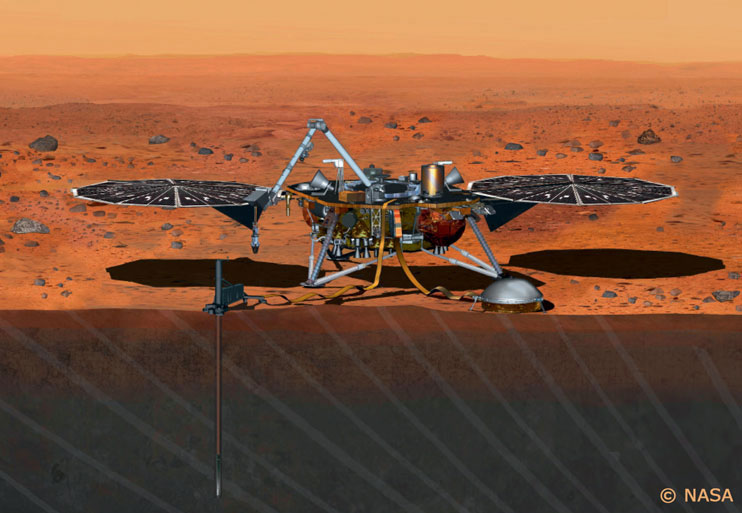
|
InSight (Interior exploration using Seismic Investigations, Geodesy and Heat Transport) is a NASA Discovery Program mission that will deploy a single geophysical lander on Mars to study its deep interior. This is the first comprehensive surface-based geophysical investigation of Mars. The overarching mission goals are to illuminate the fundamentals of formation and evolution of terrestrial (Earth-like) planets by investigating the interior structure and processes of Mars, and more specifically to determine the thickness, structure and composition of the crust, mantle and core, and to measure the rate and distribution of seismic activity and the rate of meteorite impacts. The Mission should land in November 2018 and have a lifetime of about two Earth years. A set of 3-component broadband and short period seismometers (collectively known as SEIS) will be deployed beside the lander. In additional, InSight will also deploy a heat flow probe (HP3), a geodetic experiment (RISE), a magnetometer, and meteorological sensors. Seismological investigations of Mars have so far been based on modeling and synthetic data; starting in 2018, waveform data will be returned from Mars and the era of 'Seismology on Mars' will begin. Building on our expertise and infrastructure for earthquake monitoring and seismic data processing on Earth, the SED will take the lead role in the building a catalogue of seismic events recorded by SEIS (the 'Marsquake Service’). This service will comprise automatic and reviewed event detection and characterization of local and teleseismic events, as well as meteor impacts. The goal of this service is to provide a comprehensive high-quality event catalogue for Mars that is critical to the SEIS project, in particular as input to the development of Martian crustal and deep structure models. We are adapting advanced single-seismometer analysis techniques developed on the Earth to provide locations for Martian seismicity. Creating the Marsquake Service is a collaboration between the SED and the SEG groups at the ETH Zurich. |
|---|---|
| Project Leader al SED | Prof. Domenico Giardini (InSight Co-I) |
| Partecipanti del SED | Dr. John Clinton (Seismic Network Manager, InSight Co-I) Dr. Amir Khan (Affiliated Scientist) Dr. Martin van Driel (PostDoc) Dr. Maren Böse (Project Scientist) Dr. Fabian Euchner (PostDoc) Dr. Savas Ceylan (IT Specialist) |
| Finanziamento | SNF / SSO |
| Durata | 2015 - 2018 |
| Parole chiavi | Planetary seismology, Mars, InSight, single-station approaches, seismic monitoring |
| Settore di ricerca | |
| Link alla Website |
RISE: Real-time earthquake rIsk reduction for a reSilient Europe
SERA: Seismology and Earthquake Engineering Research Infrastructure Alliance for Europe
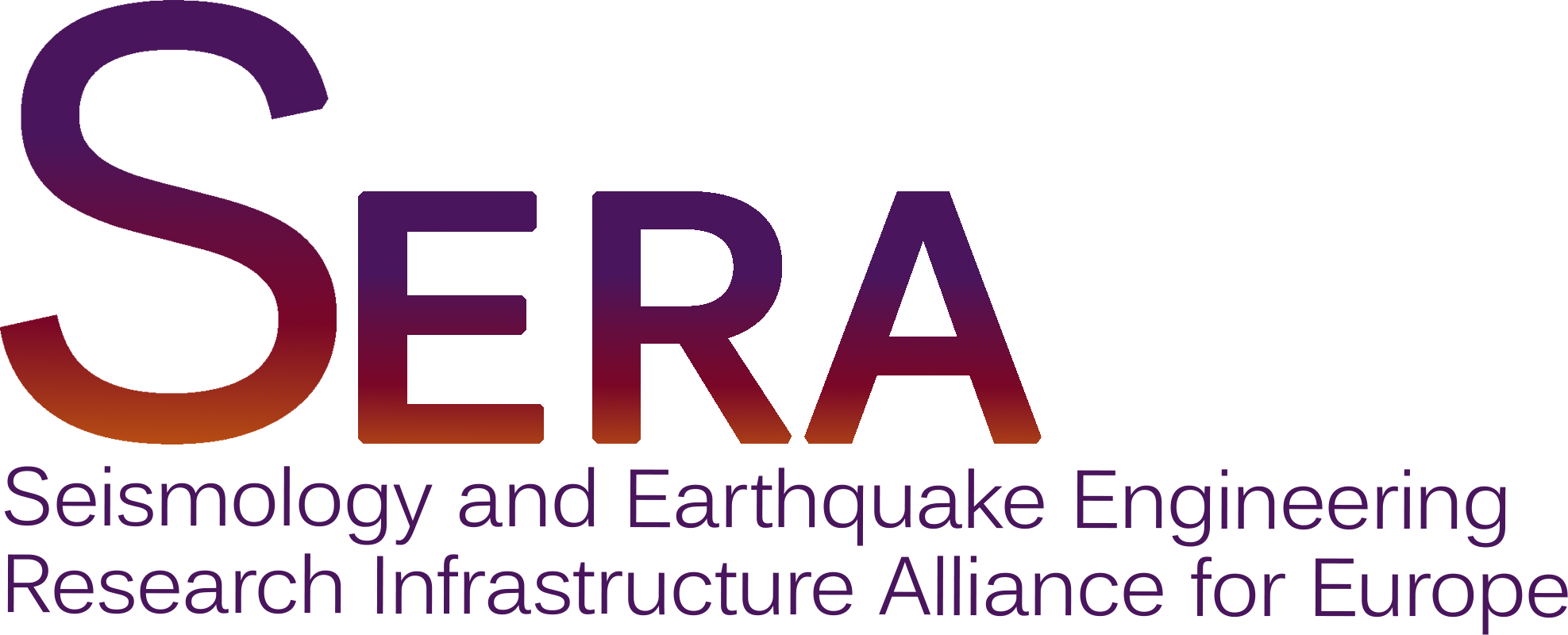
|
The "Seismology and Earthquake Engineering Research Infrastructure Alliance for Europe" (SERA) aims to reduce the risk posed by natural and anthropogenic earthquakes. SERA will significantly improve the access to data, services and research infrastructures, and deliver solutions based on innovative research and development projects in seismology and earthquake engineering. SERA is a Horizon 2020-supported programme responding to the priorities identified in the call INFRAIA-01-2016-2017 “Research Infrastructure for Earthquake Hazard”. SERA involves 31 partners and 8 linked third parties in Europe. To reach its objectives, SERA will…
These efforts will lead to a revised European Seismic Hazard reference model for consideration in the ongoing revision of the Eurocode 8 and to a first, comprehensive framework for seismic risk modeling at European scale. SERA will further develop new standards for future experimental observations in earthquake engineering, for the design of instruments and networks for observational seismology, and reliable methodologies for real-time assessment of shaking and damage. By expanding the access to seismological observations and assisting in connecting infrastructures and communities in the fields of deep seismic sounding, experimental earthquake engineering and site characterization SERA facilities collaboration and innovations in the respective areas. SERA will also contribute meaningfully to the construction and validation of EPOS and effectively communicate its activities and achievements to the relevant stakeholders. |
|---|---|
| Project Leader al SED | Prof. Stefan Wiemer |
| Partecipanti del SED | Dr. Florian Haslinger, Dr. Laurentiu Danciu, Michèle Marti, Stephanie Schnydrig, Dr. Francesco Grigoli |
| Finanziamento | SBFI |
| Durata | 2017 - 2020 |
| Parole chiavi | seismology, earthquake engineering, seismic hazard and risk, anthropogenic seismicity, deep underground, earth structure, georesources, geohazards |
| Settore di ricerca | Seismic Hazard and Risk, Earthquake Engineering, Operational Earthquake Forecasting, Induced Seismicity |
| Link alla Website |
Fields of Research
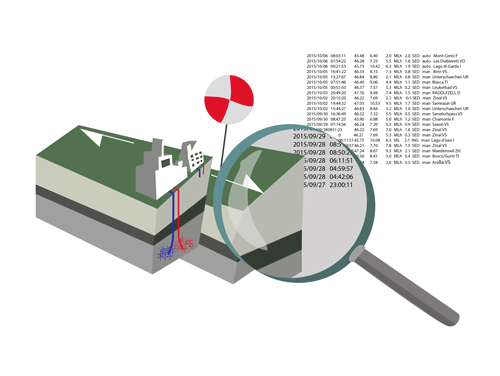
Valutazione della pericolosità sismica
Basel Erdbebenvorsorge: Earthquake Risk Mitigation for the City of Basel
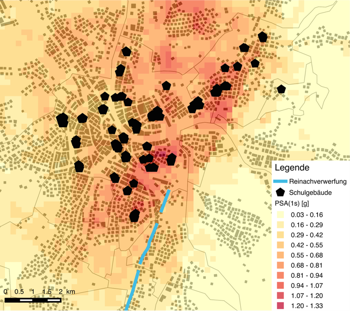
|
Following the seismic microzonation of Basel, the project «Basel Erdbebenvorsorge» was funded by the canton Basel-Stadt. It aimed first at improving the seismic network in Basel and collecting data for the next generation of microzonation studies, and second at proposing earthquake scenarios and risk computations for all cantonal school buildings. This study sets the framework for studies including the whole city, supporting earthquake mitigation and crisis management. In a first phase, 6 new modern strong-motion stations have been installed, complementing the installations from the SSMNet renewal project. The sites have been characterized through geophysical measurements. In addition, 5 temporary stations have been installed for the period of the project. In a second phase, a new amplification map was developed accounting for all information collected for the completed microzonation study and more recent data. The third phase was the development of a risk framework using the Openquake software. The company Resonance Ingénieurs-Conseils performed the assessment of the capacity curves of the school buildings, that were implemented through fragility curves. A particular focus of the project was put on the uncertainties of the risk-calculation process. Scenarios for typical events of the area were assessed, based on the historical seismicity and the de-aggregation of the regional seismic hazard. The effect of retrofitting of the school-building stock through the ongoing HARMOS project was quantified with a cost-benefit analysis. |
|---|---|
| Project Leader al SED | Donat Fäh |
| Partecipanti del SED | Clotaire Michel |
| Finanziamento | Kanton Basel-Stadt |
| Durata | 2013-2016 |
| Parole chiavi | Seismic risk, seismic vulnerability, microzonation, school buildings, site effects, Openquake, strong motion |
| Settore di ricerca | Earthquake Hazard & Risk, Engineering Seismology |
| Publicazioni |
Michel, C., Hannewald, P., Lestuzzi, P., Fäh, D., & Husen, S. (2017). Probabilistic mechanics-based loss scenarios for school buildings in Basel (Switzerland). Bulletin of Earthquake Engineering 15(4), 1471–1496. doi: 10.1007/s10518-016-0025-2 Michel, C., Fäh, D., Edwards, B., & Cauzzi, C. (2017). Site amplification at the city scale in Basel (Switzerland) from geophysical site characterization and spectral modelling of recorded earthquakes. Physics and Chemistry of the Earth, Parts A/B/C 98, 27-40. doi: 10.1016/j.pce.2016.07.005 Michel C., Fäh D. (2016). Basel earthquake risk mitigation - Computation of scenarios for school buildings. Technical Report. Zürich, Switzerland: ETH-Zürich. doi: 10.3929/ethz-a-010646514 Michel C., Fäh D., Edwards B., Cauzzi C. (2016, in press). Site amplification at the city scale in Basel (Switzerland) from geophysical site characterization and spectral modelling of recorded earthquakes. Physics and Chemistry of the Earth Special Issue “Advances in seismic site response: standard-practice and innovative methods”. doi: 10.1016/j.pce.2016.07.005 Michel, C., Fäh, D., Lestuzzi, P., Hannewald, P. and Husen, S. (2015). Detaillierte Erdbeben-Schaden-szenarien für die Schulgebäude im Kanton Basel-Stadt. Dokumentation SIA D 0255 Erdbeben und bestehenden Bauten, 14. D-A-CH-Tagung, Zürich. Michel C., Hannewald P., Lestuzzi P., Fäh D., Husen S. (2016, in press). Probabilistic mechanics-based loss scenarios for school buildings in Basel (Switzerland). Bulletin of Earthquake Engineering. doi: 10.1007/s10518-016-0025-2 Résonance (2016). Basel earthquake risk mitigation – Capacity curves of school buildings. Technical Report. Zürich, Switzerland: ETH-Zürich. doi: 10.3929/ethz-a-010647300 |
3D-ASEMB: Analysis of Site Effects Using 3-D Models for the Area of Bucharest City
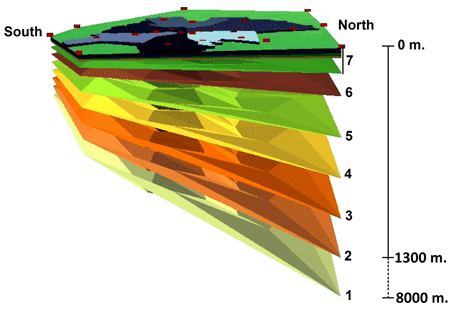
|
The objective of this project is the microzonation of the Bucharest city (Romania). For a better understanding of the geological structure under Bucharest, non-invasive methods are used, as: wavelet-polarization analysis at each station, H/V for ambient vibrations and earthquakes, and the three-components array analysis of ambient vibration recordings from URS experiment, in order to retrieve the characteristics of surface waves. Surface wave dispersion curves, their ellipticity and the data from boreholes (depth < 100m) are jointly inverted to estimate the velocity structure under the city. The final 3D structure will be used for the numerical simulation of the seismic waves propagation from the Vrancea intermediate-depth source to the city in order to investigate the seismic hazard in the city. Data used in this project are from: National Institute of Earth Physics, CRC461-Proiect URS – URban Seismology 2003-2004, BIGSEES ”BrIdging the Gap between Seismology and Earthquake Engineering: from the Seismicity of Romania towards a refined implementation of seismic action EN1998-1 in earthquake resistant design of buildings” |
|---|---|
| Project Leader al SED | Donat Fäh |
| Partecipanti del SED | Elena Manea, Clotaire Michel, Manuel Hobiger, Valerio Poggi |
| Finanziamento | Sciex-NMSch Programme, No. 13.123 |
| Durata | 2014-2015 |
| Parole chiavi | Ambient Vibration, Array Processing, 3D Geophysical Model, Seismic Hazard |
| Settore di ricerca | Earthquake Hazard & Risk, Engineering Seismology |
| Publicazioni |
Manea, E.F, Michel C., Poggi V., Fäh D., Radulian M., Bălan S.F. (2016). Improvement of the shear wave velocity structure beneath Bucharest (Romania) using ambient vibrations. Geophysical Journal International, under review. Manea, E.F., Michel C., Hobiger M., Fäh D., Cioflan C.O., Radulian M. (2016). Analysis of the seismic wave field in the Moesian Platform (Bucharest area) for hazard assessment purposes. In preparation. |
| Presentazioni |
Manea E. F., Hobiger M., Michel C., Fäh D., Cioflan C. O. (2016). Analysis of the seismic wavefield in the Moesian Platform (Bucharest area). Geophysical Research Abstracts Vol. 18, EGU 2016, 930. Access for SSA members only Manea E. F., Michel C., Fäh D., Poggi V., Edwards B., Cioflan C. O., Radulian M., Balan S. F. (2015). Improvement of the Shear Wave Velocity Structure Beneath Bucharest (Romania) Using Non-Invasive Techniques. Seismological Society of America (SSA 2015) Annual Meeting, Pasadena, California, 21-23 April 2015. Access for SSA members only |
NERA: Network of European Research Infrastructures for Earthquake Risk Assessment and Mitigation

|
NERA was a project in the Seventh Framework Program (FP7) of the European Commission (EC) that integrated key research infrastructures in Europe to monitor earthquakes and assess their hazard and risk to improve and make a long-term impact on the assessment and the reduction of the vulnerability of constructions and citizens to earthquakes. Our group was involved in the Work package JRA1, Waveform modelling and site coefficients for basin response and topography, and Workpackage NA5, Networking near-fault observatories. The key objective of JRA1 was to establish some scientifically solid and practically acceptable propositions to incorporate basin and surface topography effects in seismic design (building codes, microzonation studies, critical facilities). We contributed with a systematic study of the topographic site effects with emphasis on reasonable characterization of the both topographic site structures and observed effects on ground motion. We gathered available earthquake and ambient vibration recordings from sites with pronounced topography (Europe, Japan) and performed joint analysis with digital elevation models. The results and final recommendations have been published in a report. These conclusions contribute to the ongoing (light) revision of EC8. The objective of NA5 was to collaborate in sharing of technological and scientific experience and know-how between the near-fault observatories. We shared our experience with the installation (including data gathering and data archiving) of various instruments in the Valais region. This workpackage represented an infrastructural support for workpackage 2 of the project REAKT. |
|---|---|
| Project Leader al SED | Donat Fäh |
| Partecipanti del SED | Jan Burjanek |
| Finanziamento | EC |
| Durata | 2010-2014 |
| Parole chiavi | Topography, site-effects, near-fault observatories |
| Settore di ricerca | |
| Publicazioni |
Burjanek, J., Edwards, B. and Fäh, D. (2013). Empirical evidence of topographic site effects: a systematic approach. Geophys. J. Int. 197, 608-619. doi: 10.1093/gji/ggu014 |
| Reports / Risultati |
PRP PEGASOS Refinement Project
In the 1990s the Swiss Federal Nuclear Safety Inspectorate (HSK) identified the need to update the seismic hazard assessments for Swiss NPPs and in 1998 asked the Swiss NPP operators to draw up a new hazard study that would comply with SSHAC level 4 (SSHAC, 1997) requirements. Nagra (the National Co-operative for the Disposal of Radioactive Wastes) was commissioned to plan, organize and perform such a study – the PEGASOS project (Probabilistische Erdbeben-Gefährdungs-Analyse für KKW-Standorte in der Schweiz). The project involved more than 20 experts from seven European countries, with support provided by 25 Swiss and foreign specialists and consultants. The project was completed in the summer of 2004. In 2008 the "PEGASOS Refinement Project" was launched in order to address potential refinements. As part of this project the SED was commissioned to provide input and to develop specific products:
Finite-fault near-source broadband ground-motion simulation |
|
| Project Leader al SED | Donat Fäh |
|---|---|
| Finanziamento | |
| Durata | 2008-2013 |
| Parole chiavi | Earthquake catalogues, earthquake sources, ground motion prediction equations, numerical ground-motion simulations |
| Settore di ricerca | Seismic hazard assessment |
COGEAR: Coupled Seismogenic Geohazards in Alpine Regions
Basel Microzonation
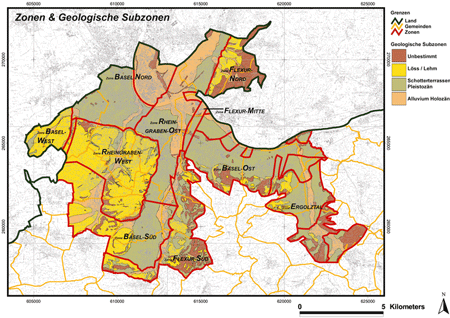
|
For the city of Basel, a qualitative microzonation was performed in 1997. The zonation was mainly based mainly on the properties of the quaternary sediments. This triggered a study that provided a quantitative assessment of ground motion amplification in order to determine which levels of amplifications have to be taken into account a site-specific hazard assessment in the Basel area. It is the result of two large projects, the ETH project “Earthquake scenarios for Switzerland” (1997-2002) and the INTERREG project “Seismic Microzonation in the upper Rhine Graben area” (2003-2006) (Fäh end Huggenberger, 2006). Earthquakes in the Basel region triggered the strong motion network in Basel and provided a data set for comparison. Spectral ratios from recordings confirm the results of the microzonation study. Finally uniform hazard spectra were derived for each zone by combining the hazard on rock with the amplification functions. The microzonation is published on the Internet: Basel Landschaft: http://geoview.bl.ch Basel Stadt: www.geo.bs.ch/erdbebenmikrozonierung |
|---|---|
| Project Leader al SED | Donat Fäh |
| Partecipanti del SED | Hans Havenith, Ivo Oprsal, Brian Steiner, Sybille Steimen, Philipp Kästli, Gabriela Stamm, Johannes Ripperger, Jan Burjanek |
| Finanziamento | Interreg, Kantone Basel Stadt & Basel Landschaft |
| Durata | 2003-2009 |
| Parole chiavi | Microzonation, Basel |
| Settore di ricerca | Earthquake Hazard & Risk, Engineering Seismology, Microzonation |
| Publicazioni |
Fäh, D. and P. Huggenberger (2006). INTERREG III, Erdbebenmikrozonierung am südlichen Oberrhein. Zusammenfassung für das Projektgebiet Gebiet in der Schweiz. CD and Report (in german; available from the authors). Fäh, D. and T. Wenk (2009). Mikrozonierung für die Kantone Basel Stadt und Basel Landschaft: Optimierung der Form der Antwortspektren und der Anzahl der Mikrozonen. In: Schweizerischer Erdbebendienst ETH Zürich: Abschlussbericht: Teilbericht B Projekt "Umsetzung der Mikrozonierung in den Kantonen Basel Stadt und Basel Landschaft". Fäh, D., Steimen, S., Oprsal, I., Ripperger, J., Wössner, J., Schatzmann, R., Kästli, P., Spottke, I. and P. Huggenberger (2006). The earthquake of 250 A.D. in Augusta Raurica, a real event with a 3D site-effect?. Journal of Seismology 10, 459-477. Fäh, D., Gisler, M., Jaggi, B., Kästli, P., Lutz, T., Masciadri, V., Matt, C. Mayer-Rosa, D., Rippmann, D., Schwarz-Zanetti, G., Tauber, J., Wenk, T. (2009). The 1356 Basel earthquake: an interdisciplinary revision. Geophys. J. Int. 178, 351-374. Fäh, D. Ripperger, J., Stamm, G., Kästli, P., and J. Burjanek (2009). Mikrozonierung für die Kantone Basel Stadt und Basel Landschaft: Validierung und Umsetzung der Mikrozonierung (2006-2008). In: Schweizerischer Erdbebendienst ETH Zürich: Abschlussbericht: Teilbericht A Projekt "Umsetzung der Mikrozonierung in den Kantonen Basel Stadt und Basel Landschaft". Havenith, H.-B., Fäh, D., Polom, U. and A. Roulle (2007). S-wave velocity measurements applied to the seismic microzonation of Basel, Upper Rhine Graben. Geophys. J. Int. 170, 346-358. Kind, F. (2002). Development of microzonation methods: application to Basel, Switzerland. Ph.D. thesis, ETH Zürich, Available in electronic form from www.ethbib.ethz.ch. Kind, F., Fäh, d., & Giardini, D. (2005). Array measurements of s-wave velocities from ambient vibrations. Geophysical Journal International 160, 114-126. Meghraoui, M., Delouis, B., Ferry, M., Giardini, D., Huggenberger, P., Spottke, I., & Granet, M. (2001). Active normal faulting in the Upper Rhine Graben and paleoseismic identification of the 1356 Basel Earthquake. Science 293, 2070-2073. Noack, T. (1993). Geologische Datenbank der Region Basel. Eclogae geol. Helv. 86, 283-301. Noack, T., Kruspan, P., Fäh, D., & Rüttener, E. (1999). Mikrozonierung von Basel-Stadt. Geologischer Bericht Nr. 24, Landeshydrologie und -Geologie Schweiz. Oprsal, I., Fäh, D., Mai, M. and D. Giardini (2005). Deterministic earthquake scenario for the Basel area - Simulating strong motion and site effects for Basel, Switzerland. J. Geophys. Res. 110, B04305. doi: 10.1029/2004JB003188 Oprsal, I., Fäh, D. (2007). 1D vs 3D strong ground motion hybrid modelling of site, and pronounced topography effects at Augusta Raurica, Switzerland - Earthquakes or battles? . 4th International Conference on Earthquake Geotechnical Engineering, June 25-28, 2007, Paper No. 1416. Ripperger, J., Kästli, P., Fäh, D., Giardini, D. (2009). Ground motion and macro-seismic intensities of a seismic event related to geothermal reservoir stimulation below the city of Basel - observations and modelling. Geophysical J. Int. 179, 1757–1771. Zechner, E., Kind, F., Fäh, D., & Huggenberger, P. (2001). 3-D Geological model of the Southern Rhine Graben compiled on existing geological data and geo-physical reference modeling. Abstract Volume of the 2nd EUCOR-URGENT Workshop, 7.-11. October, Mont Saint-Odile, Strasbourg, France, p. 43. |
Pericolosità sismica Svizzera 2004
Lake Tsunamis: Causes, Consequences and Hazard
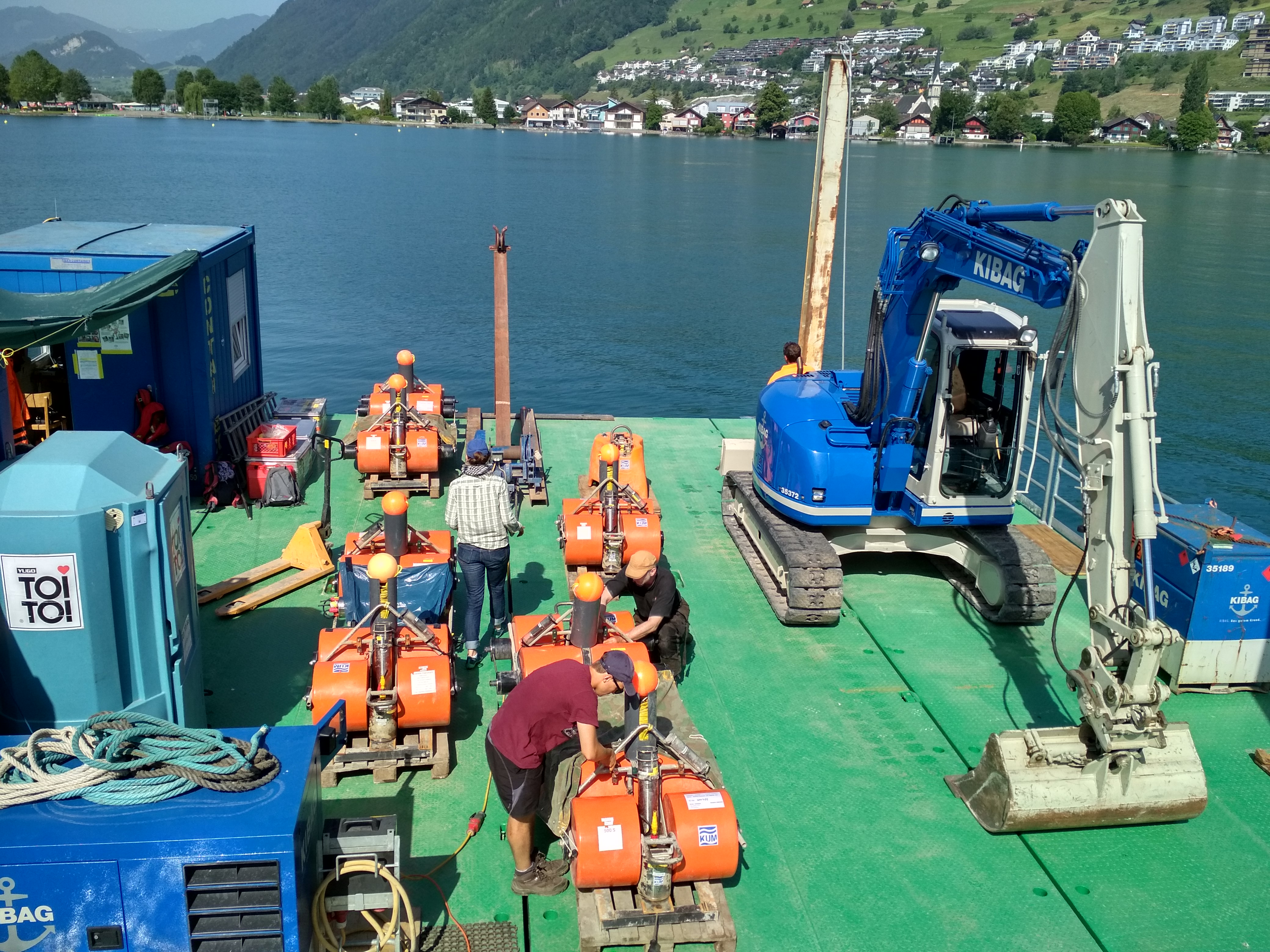
|
Tsunamis do not only happen in oceans, but they do also occur in lakes. This project aims to understand the trigger mechanisms, preconditions, processes and impacts of lake tsunamis within an interdisciplinary environment (limnogeologists, seismologists, geotechnical specialists, hydraulic engineers and hazard specialists). Two Work Packages of this project (WPresponse and WPhazard/ Tsunami-CH) are conducted at SED. WPresponse aims to characterize the sediment-mechanical characteristics,to estimate the volumes of the sediments in Lake Lucerne, and to study the stability of the sediments under seismic shaking. For this purpose, ocean bottom seismometers (OBS) are placed in Lake Lucerne at selected locations (see map). These OBS are recording the seismic signal on short (days) and long (months) intervals. Cone Penetration Test (CPT) measurements are used to define the geotechnical characteristics of the sediment. This WP is financed by SNSF and ETH. WPhazard aims to assess the tsunami hazard in Switzerland. Even though historical reports and studies of lake sediments in Switzerland are documenting numerous tsunamis, the basics and methods for assessing this danger - and the resulting risk on land - are still lacking. Also the typical warning times, the possibilities and limits of alarming are currently only insufficiently known. This work package, financed by the FOEN, is intended to comprehensively characterize for the first time the danger of tsunamis in Swiss lakes such as Lake Lucerne, Lake Brienz, and others and thus contribute to a sustainable and practice-oriented risk management. |
|---|---|
| Project Leader al SED | Donat Fäh, Stefan Wiemer |
| Partecipanti del SED | Katrina Kremer, Agostiny Lontsi, Anastasiia Shynkarenko, Michael Strupler |
| Finanziamento | ETH, SNF, FOEN |
| Durata | 2017-2021 |
| Parole chiavi | Lake tsunami, slope stability, Tsunami hazard, Swiss Lakes, Ocean bottom seismometer |
| Settore di ricerca | Earthquake Hazard & Risk |
| Link alla Website | |
| Publicazioni |
Nigg, V., Bacigaluppi, P., Vetsch, D. F., Vogel, H., Kremer, K., & Anselmetti, F. (2021). Shallow-water tsunami deposits: evidence from sediment cores and numerical wave propagation of the 1601 CE Lake Lucerne event. Geochemistry, Geophysics, Geosystems, 22 (12). doi: https://doi.org/10.1029/2021GC009753 Lontsi, A.M., Shynkarenko, A., Kremer, K., Hobiger, M., Bergamo, P., Fabbri, S., Anselmetti, F. and Fäh, D. (2022). A Robust Workflow for Acquiring and Preprocessing Ambient Vibration Data from Small Aperture Ocean Bottom Seismometer Arrays to Extract Scholte and Love Waves Phase-Velocity Dispersion Curves. Pure Appl. Geophys. 179, 105–123. doi: https://doi.org/10.1007/s00024-021-02923-8 Shynkarenko, A., Lontsi, A.M., Kremer, K., Bergamo, P., Hobiger, M., Hallo, M., and Fäh, D. (2021). Investigating the subsurface in a shallow water environment using array and single-station ambient vibration techniques. Geophysical Journal International. 227 (3). doi: https://doi.org/10.1093/gji/ggab314 |
Monitoraggio in tempo reale
FAULTS_R_GEMS
Earthquakes are controlled by the properties of the underlying fault or fault system, along which rupture is occurring. For example,
In the FAULTS_R_GEMS (Properties of FAULTS, a key to Realistic Generic Earthquake Modeling and hazard Simulation) project, we collaborate with scientists at Géoazur (Université Côte d'Azur), IFSTTAR Paris, Géosciences in Montpellier, Inria Sophia, LJAD in Nice, IPGP in Paris, IRSN, ENS Paris, the University of Arizona, and the University of Pisa, with the goal to better understand the interactions between seismic faults and earthquakes, and to use these findings to improve seismic hazard simulations and earthquake early warning (EEW) in terms of prior probabilities. |
|
| Project Leader al SED | Dr. Maren Böse |
|---|---|
| Partecipanti del SED | Alexandra Hutchison, John Clinton, Frederick Massin |
| Finanziamento | French ANR |
| Durata | 2017-2021 |
| Parole chiavi | fault properties, rupture simulations, ground-motions, earthquake early warning, prior probability, Bayesian statistics |
| Settore di ricerca | Earthquake Early Warning |
| Link alla Website | |
| Publicazioni |
|
Monitoring of Icequakes on Aletschgletscher
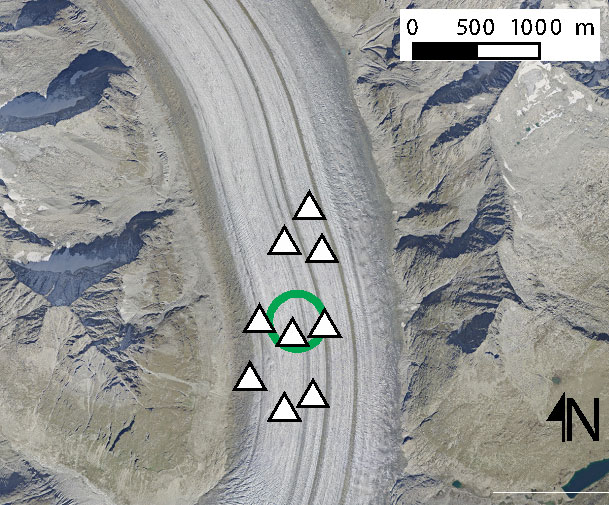
|
The study of small earthquakes related to glacier flow, so-called icequakes, can reveal important insights into the dynamics and hydraulics of glaciers. Icequakes near the glacier bed are particularly interesting, because they may be a manifestation of microseismic stick-slip sliding. This phenomenon is not fully understood and has yet to be captured in ice flow models. At the same time, basal seismicity can be a manifestation of hydraulic fracturing as melt water opens up new water channels within and beneath the glacier, a process, which is analogous to the hydraulic stimulation within geothermal reservoirs. This project focuses on the occurrence of sliding-related stick-slip icequakes beneath Aletschgletscher. Whereas these events have been confirmed beneath the polar ice sheets (e.g. Smith et al., 2015; Roeoesli et al., 2016), it is to date not clear if they also exist beneath relatively flat Alpine glaciers. To this end, the SED conducted a two-step seismometer deployment on the glacier tongue. In a first step, three shallow borehole seismometers were installed and maintained for 1.5 years (January 2015-July 2016). These data identified an icequake cluster at the glacier bed, which was monitored in near-real time with the help of state-of-the-art real-time data communication. In June 2016, an additional network with six seismometers was installed above the cluster to confirm that the recorded icequakes are indeed stick-slip events and to provide better hypocenter locations. The seismic Aletschgletscher record is unique in that it contains stick-slip icequakes recorded at an unrivaled quality over more than a year. This will provide an unprecedented look at seismogenic stick-slip sliding and its changes over the course of a full year. As a result of harsh weather conditions in high-melt areas, on-ice seismometer installations are extremely difficult on Alpine glaciers. Consequently, the Aletschgletscher data set offers a first-of-its-kind view on how stick-slip seismicity changes as the glacier reacts to climatic changes. Our project is embedded in cross-disciplinary collaborative research between the Glaciology division at the Laboratory of Hydraulics, Hydrology, and Glaciology (VAW) at ETH Zurich and the Exploration and Environmental Geophysics group at the Institute of Geophysics at ETH Zurich. In the past, these groups have collected milestone records in the field of glacier seismology (Podolskiy and Walter, 2016). The joint interpretation of the Aletschgletscher data will help to improve our understanding of glacier flow and its reaction to climate change and glacier retreat, also affecting the Swiss Alps. |
|---|---|
| Project Leader al SED | Prof. Dr. Fabian Walter |
| Partecipanti del SED | Prof. Dr. E. Kissling |
| Finanziamento | Swiss Seismological Service |
| Durata | 2015-2016 |
| Parole chiavi | Glacier, Seismology, Climate Change, Cryosphere |
| Settore di ricerca | Glacier Seismology |
| Publicazioni |
Podolskiy E.A. and F. Walter (2016). Cryoseismology. Reviews of Geophysics 54. doi: 10.1002/2016RG000526 Röösli C., A. Helmstetter, F. Walter, and E. Kissling (2016). Meltwater influences on deep stick-slip icequakes near the base of the Greenland Ice Sheet. Journal of Geophysical Research: Earth Surface 121, 223–240. doi: 10.1002/2015JF003601 Smith E. C., A. M. Smith, R. S. White, A. M. Brisbourne, and H. D. Pritchard (2015). Mapping the ice‐bed interface characteristics of Rutford Ice Stream, West Antarctica, using microseismicity. Journal of Geophysical Research: Earth Surface 120(9), 1881-1894. |
GLISN: Swiss Participation in the Greenland Ice Sheet Monitoring Network
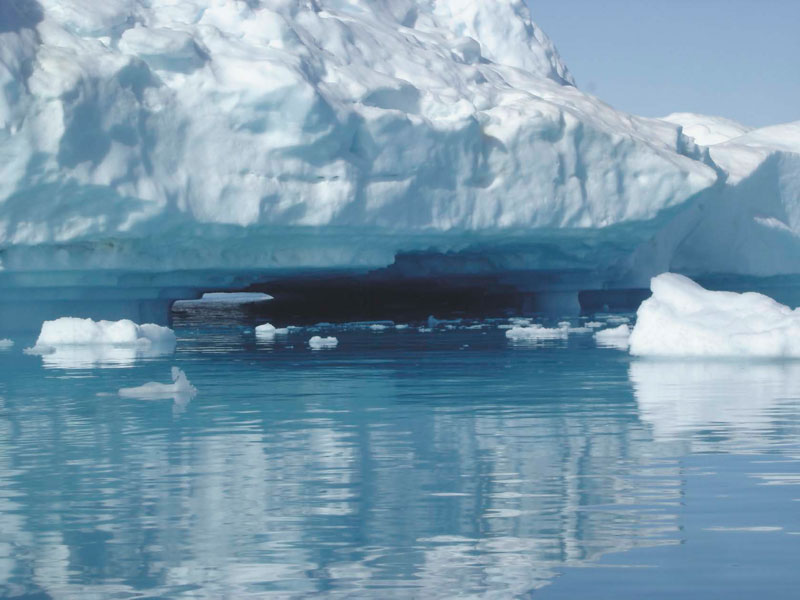
|
The SED participated in building a state-of-the art seismic network in the Arctic. We built and now continue to operate 3 stations in the new international broadband seismic capability for Greenland, the GreenLand Ice Sheet monitoring Network (GLISN). This real-time sensor array enhances and upgrades performance of the very limited pre-existing Greenland seismic infrastructure for detecting and characterizing glacial earthquakes and other phenomena emitting seismic waves. The Greenland Ice Sheet is changing, and seismology has the means to “hear” and measure these changes. Continuous, long-term monitoring of the dynamics of the Greenland Ice Sheet and its relationship to global climate change is a fundamental observational enterprise which requires multi-sensing techniques. The development of GLISN brings the seismology component into focus for monitoring Greenland’s Ice Sheet. Glacial earthquakes have been observed along the edges of Greenland with strong seasonality and increasing frequency since 2002 by continuously monitoring data from the Global Seismographic Network (GSN). These glacial earthquakes in the magnitude range 4.6-5.1 may be modeled as a large glacial ice mass sliding downhill several meters (e.g. 10 km3 by 10 m) on its basal surface over a duration of 30 to 60 seconds. Although the mechanics of sudden sliding motions at the glacial base are not known, seasonal and temporal patterns are consistent with a dynamic response to climate warming driven by an increase in surface melting and supply of meltwater to the glacial base, and suggest that the glacial earthquakes may serve as a marker of ice-sheet response to external forcing. Before GLISN, the detection and characterization of smaller glacial earthquakes was limited by the propagation distance to globally distributed seismic stations. Now, glacial earthquakes can be identified only using the more than 30 GLISN seismic stations within and surrounding Greenland. Because of the long durations of sliding, these glacial earthquakes do not appear in standard earthquake catalogs, and are best detected by broadband seismometers, which accurately measure both fast (< second) and slow (> 100sec) vibrations. Such seismic monitoring of the Greenland Ice Sheet via glacial earthquakes will complement both surficial GPS monitoring and remote sensing from satellites, by providing sensitivity to the dynamics of the glaciers at basal depths. In addition, real-time detection of glacial earthquakes permits rapid response and focusing of other sensing techniques to the dynamic region of the Ice Sheet. All the data from the GLISN is openly available to anyone in real-time, without restriction. |
|---|---|
| Project Leader al SED | John Clinton |
| Finanziamento | SNF R’Equip |
| Durata | 2008-2010 |
| Parole chiavi | Greenland, Seismic Networks, Ice Sheet |
| Settore di ricerca | Seismic Network, Seismotectonics, Real-time monitoring |
| Link alla Website | |
| Publicazioni |
Clinton, J. F., M. Nettles, F. Walter, K. Anderson, T. Dahl-Jensen, D. Giardini, A. Govoni, W. Hanka, S. Lasocki, W. S. Lee, D. McCormack, S. Mykkeltveit, E. Stutzmann and S. Tsuboi (2015). Seismic Network in Greenland Monitors Earth and Ice System. Eos Trans. AGU 95(2), 13-14. doi: 10.1002/2014EO020001 |
Allerta precoce sui terremoti
Smartphone-Network for Earthquake and Tsunami Early Warning in Chile
EPOS, EEW Testing Center
EPOS IP is part of the long term EPOS integration plan to build an operational and sustainable platform of Earth Science services. The project is funded through the European Union. In WP 9 (Near fault Observatories) of EPOS IP, we work with our colleagues at the University of Naples / AMRA, to build a testing center where a variety of scientific algorithms for real-time monitoring can be operated side-by-side and their performance independently evaluated. The initial demonstrations software for this testing center are 2 EEW approaches, the Virtual Seismologist (VS) software maintained by ETH, and PresTo from University of Naples / AMRA. The testing platform is the Irpinia seismic network near Naples. |
|
| Project Leader al SED | Dr. John Clinton |
|---|---|
| Partecipanti del SED | Frederick Massin, Philipp Kästli, Enrico Ballarin |
| Finanziamento | EU |
| Durata | 2017-2020 |
| Parole chiavi | Earthquake Early Warning, Testing Center |
| Settore di ricerca | Real-Time Seismology, Earthquake Engineering |
| Link alla Website | |
ShakeAlert
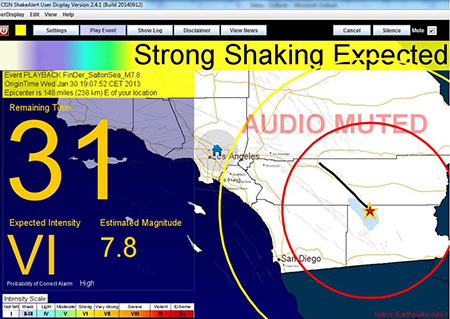
|
The objective of the ShakeAlert project is to implement a prototype Earthquake Early Warning (EEW) system for California and the pacific northwest of the United States. The system is currently sending warnings of imminent strong ground shaking to a selected group of test users. The project comprises algorithm development, EEW system design and implementation, and public outreach. The SED was involved in Phase I – III of the project, implementing and testing the Virtual Seismologist (VS) [Cua and Heaton, 2009], a Bayesian approach to EEW. In Phase III, the SED team also began to contribute to the development and implementation of FinDer, the first finite fault algorithm to be included in the prototype system. Currently about 300 scientists and engineers and several project partners from the public and private sector receive alerts from the ShakeAlert EEW system. The ShakeAlert project continues without formal ETH participation, though VS and FinDer continue to be core components in the development system. |
|---|---|
| Project Leader al SED | Georgia Cua (Phase I + II), John Clinton (Phase III) |
| Partecipanti del SED | Michael Fischer (former member), Marta Caprio (former member), Men-Andrin Meier (former member), Yannik Behr (former member), Maren Böse |
| Finanziamento | United States Geological Survey |
| Durata | 3 x 3 years |
| Parole chiavi | Prototype Earthquake Early Warning system for California and the Pacific northwest of the United States |
| Settore di ricerca | Earthquake Early Warning |
| Link alla Website | |
| Publicazioni |
Meier, M.-A., T. Heaton, and J. Clinton (2015). The Gutenberg Algorithm: Evolutionary Bayesian Magnitude Estimates for Earthquake Early Warning with a Filter Bank. Bull. Seismol. Soc. Am. 105(5), 2774-2786. doi: 10.1785/0120150098 Böse, M., C. Felizardo, T.H. Heaton (2015). Finite-Fault Detector Algorithm (FinDer): Going Real Time in Californian ShakeAlert Warning System. Seismological Research Letters 86(6), in press. Behr, Y., J. F. Clinton, P. Kästli, C. Cauzzi, and M.-A. Meier (2015). Anatomy of an Earthquake Early Warning ( EEW ) Alert : Predicting Time Delays for an End-to-End EEW System. Seismological Research Letters 86(3), 1-11. doi: 10.1785/0220140179 Cua, G. B., M. Fischer, T. H. Heaton, and S. Wiemer (2009). Real-time Performance of the Virtual Seismologist Earthquake Early Warning Algorithm in Southern California. Seismological Research Letters 80(5), 740-747. doi: 10.1785/gssrl.80.5.740 |
| Presentazioni |
G. Cua, R. Allen, M. Boese, H. Brown, D. Given, M. Fischer, E. Hauksson, T. Heaton, M. Hellweg, M. Liukis, T. Jordan, O. Khainovski, P. Maechling, D. Neuhauser, D. Oppenheimer, K. Solanki, M. Caprio Three Years of Comparative Real-Time Earthquake Early Warning Testing in California. PDF Yannik Behr, John Clinton, Philipp Kästli, Roman Racine, Men-Andrin Meier, Carlo Cauzzi, Georgia Cua What to Expect from the Virtual Seismologist: Delay Times and Uncertainties of Initial Earthquake Alerts in California. PDF |
REAKT: Strategies and Tools for REal Time EArthquake RisK ReducTion
Sismotettonica
AlpArray
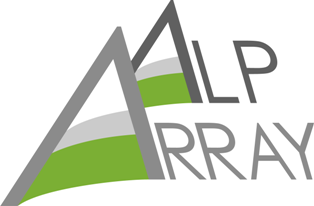
|
AlpArray is a European initiative to advance our understanding of orogenesis and its relationship to mantle dynamics, plate reorganizations, surface processes and seismic hazard in the Alps-Apennines-Carpathians-Dinarides orogenic system. The initiative integrates present-day Earth observables with high-resolution geophysical imaging of 3D structure and physical properties of the lithosphere and of the upper mantle, with focus on a high-end seismological array. AlpArray is a major scientific collaboration with over 40 participant institutions. One of the main actions of the AlpArray initiative is to collect top-quality seismological data from a dense network of temporary broadband seismic stations. This complements the existing permanent broadband stations to ensure homogeneous coverage of the Alpine area, with station spacing on the order of 30km. 24 institutions are currently involved in the AlpArray Seismic Network (AASN), which will eventually install over 250 temporary stations in 12 countries. The AASN officially started on 1 January 2016 and will operate for at least 2 years. A complimentary ocean bottom seismometer (OBS) component is expected in 2017. The Swiss contribution to the AASN is completed, with 23 temporary stations installed in Switzerland, Italy, Bosnia and Herzogovina, Croatia and Hungary. All national broadband stations also contribute to the AASN. The Seismology and Geodynamics group (SEG) and the Swiss Seismological Service (SED) at the ETH in Zurich take leading roles in the project. Prof Edi Kissling is the project coordinator. Irene Molinari (SEG), John Clinton (SED) and Gyorgy Hetenyi (former SED, now at the University of Lausanne) lead AlpArray working groups, Irene Molinari also manages the Swiss component of the AASN. More information is available on the project website. |
|---|---|
| Project Leader al SED | Prof. Edi Kissling (SEG) |
| Partecipanti del SED | Irene Molinari (SEG), John Clinton, Stefan Wiemer, ELAB |
| Finanziamento | SNF |
| Durata | 2015 - 2018 |
| Parole chiavi | Alps, earthquakes, seismic broadband network, tomography, geodynamics, surface process, orogenesis |
| Settore di ricerca | Seismotectonics, Real-time monitoring, Earthquake Hazard & Risk |
| Link alla Website | |
| Proposta |
|
| Publicazioni |
|
SAMSFAULTZ: Structure and Mechanics of Seismogenic Fault Zones
EASI: Eastern Alpine Seismic Investigation
GANSSER: Geodynamics ANd Seismic Structure of the Eastern-Himalaya Region
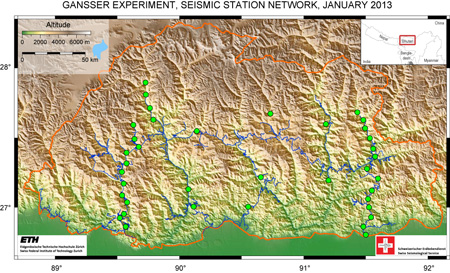
|
Bhutan, a kingdom in the Eastern Himalayas, is living in self-imposed isolation: in order to preserve local culture, traditions and the environment, foreigners can enter in groups and in limited number only. Consequently, our geoscientific knowledge is very limited compared to other parts of the orogen. The first geological map was compiled in 1983 by the famous Swiss geologist Augusto Gansser. From a geophysical perspective, Bhutan is almost a blank spot: only very limited information exists on seismicity which shows a lower level of earthquake activity compared to other parts of the Himalayas; there is knowledge neither of the structure nor of the physical properties of the crust and the lithosphere. Illuminating the deep structure of Bhutan and comparing it with the much better known Central Himalayas of Nepal is highly relevant both for evaluating the earthquake hazard and for improving our geodynamic picture of the orogen. We conducted a temporary seismic experiment in Bhutan. Two densely spaced profiles across the orogen allow us to produce the first images of the structure of the lithosphere in the Eastern Himalayas, as well as give an insight into lateral variations along the mountain belt. Our network provides reliable information on seismicity in Bhutan and establishes the first seismic velocity model of the crust. Furthermore, we will apply ambient noise tomography to map the physical properties of the lithosphere. The results will be interpreted jointly with gravity data to build physical models of the Eastern Himalayas as well as to draw conclusions on its geodynamics. Especially, seismotectonic studies that we plan to conduct by comparing different segments of the Himalayas may shed light on the origin of the apparent seismic gap in Bhutan. Augusto Gansser, "Geology Father of the Himalayas" and first geological mapmaker of Bhutan, has passed away earlier this year (2012), at the age of 101. We would like to dedicate this experiment to his memory. Outreach
|
|---|---|
| Project Leader al SED | György Hetényi |
| Partecipanti del SED | Tobias Diehl, John Clinton, Julia Singer (SEG), Edi Kissling (SEG) |
| Finanziamento | SNF |
| Durata | 3 years |
| Parole chiavi | Himalaya, Bhutan, continental collision, seismology, geodynamics, geophysics, crust, lithosphere, earthquake, seismotectonics |
| Settore di ricerca | Earth structure, Seismotectonics, Geodynamics, Earthquake Hazard & Risk |
Microseismic Monitoring of Northern Switzerland
Sismicità indotta
COSEISMIQ: Control SEIsmicity and Manage Induced earthQuakes
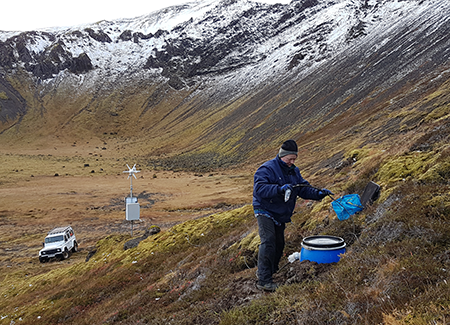
|
Over the last decade induced seismicity has become an important topic of discussion, especially owing to the concern that industrial activities could cause damaging earthquakes. Large magnitude induced seismic events are a risk for the population and structures, as well as an obstacle for the development of new techniques for the exploitation of underground georesources. The problem of induced seismicity is particularly important for the future development of geothermal energy in Europe, in fact deep geothermal energy exploitation projects such as Basel (2006) and St Gallen (2013) have been aborted due to the felt induced earthquakes they created and an increasing risk aversion of the general population. Induced seismicity is thus an unwanted product of such industrial operations but, at the same time, induced earthquakes are also a required mechanism to increase the permeability of rocks, enhancing reservoir performances. Analysis of induced microseismicity allows to obtain the spatial distribution of fractures within the reservoir, which can help, not only to identify active faults that may trigger large induced seismic events, but also to optimize hydraulic stimulation operations and to locate the regions with higher permeability, enhancing energy production. The project COSEISMIQ integrates seismic monitoring and imaging techniques, geomechanical models and risk analysis methods with the ultimate goal of implementing innovative tools for the management of the risks posed by induced seismicity and demonstrate their usefulness in a commercial scale application in Iceland. Seismic stations of the COSEISMIQ project (PDF, 0.13 MB) |
|---|---|
| Project Leader al SED | Prof. Stefan Wiemer |
| Partecipanti del SED | John Clinton, Francesco Grigoli, Florian Haslinger, Lukas Heiniger, Philipp Kaestli, Raphael Moser, Anne Obermann, Roman Racine, Antonio Pio Rinaldi, Vanille Ritz, Luca Scarabello. |
| Finanziamento | |
| Durata | 3 years (start in May 2018) |
| Parole chiavi | Induced Seismicity |
| Settore di ricerca | Induced Seismicity, Earthquake Hazard & Risk, Real-time microseismic monitoring |
| Link alla Website |
DESTRESS: Demonstration of Soft Stimulation Treatments of Geothermal Reservoirs
Induced Seismicity in Geological Nuclear Waste Disposal
RT-RAMSIS
SIAMIS-GT
To Induce or Not to Induce: an Open Problem - Study on Injection-induced Seismicity for Geo-energy Applications, from Lab to Field Scale
Towards an improved understanding of anthropogenic earthquakes: Exploiting the Grimsel controlled fault slip experiment
Monitoring Geothermieprojekt St. Gallen
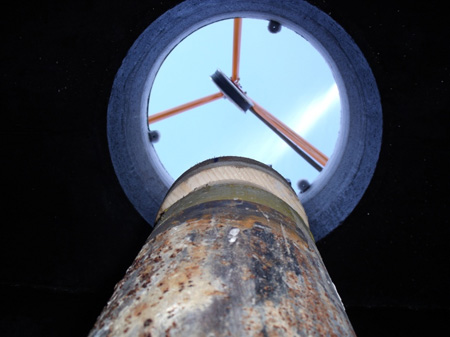
|
Nel quadro del progetto di ricerca GeoBest, dalla primavera del 2012 il Servizio Sismico Svizzero (SED) con sede all’ETH di Zurigo si occupa del monitoraggio sismico del progetto di geotermia della città di San Gallo. A tal fine, in collaborazione con la Sankt Galler Stadtwerke, l’azienda elettrica di San Gallo, il SED ha installato sei nuove stazioni sismiche nella regione di San Gallo. L’obiettivo del monitoraggio è rilevare possibili piccoli terremoti – i cosiddetti microterremoti – nelle vicinanze dei siti dove si svolgono i lavori di trivellazione, per chiarire se questi vengono causati dal progetto di geotermia o se hanno un’origine naturale. Inoltre, il progetto permette non solo di raccogliere importanti dati di base per comprendere meglio la geotermia di profondità, ma di utilizzarli come indispensabile patrimonio di esperienze per garantire alle autorità cantonali e alle imprese di gestione la sicurezza pianificatoria in vista dei futuri progetti di geotermia. Dopo l’interruzione del progetto di geotermia nella primavera del 2014, il SED svolgerà l’attività di monitoraggio in forma ridotta sino almeno al settembre 2020. La Sankt Galler Stadtwerke supporta il monitoraggio nel quadro del progetto UE "Science for Clean Energy (S4CE)". |
|---|---|
| Project Leader al SED | Toni Kraft |
| Partecipanti del SED | INDU group |
| Finanziamento | Bundesamt für Energie, Sankt Galler Stadtwerke |
| Durata | 2012-2020 |
| Parole chiavi | |
| Settore di ricerca | Induced Seismicity, Real-time monitoring |
| Link alla Website | |
| Publicazioni |
Diehl, T., Kraft, T., Kissling, E. and Wiemer, S. (2017). The induced earthquake sequence related to the St. Gallen deep geothermal project (Switzerland): Fault reactivation and fluid interactions imaged by microseismicity. Journal of Geophysical Research 122(9), 1-19. doi: 10.1002/2017JB014473 Edwards, B., Kraft, T., Cauzzi, C., Kastli, P. and Wiemer, S. (2015). Seismic monitoring and analysis of deep geothermal projects in St Gallen and Basel, Switzerland. Geophys. J. Int. 201, 1020-1037. Obermann, A., Kraft, T., Larose, E. and Wiemer, S. (2015). Potential of ambient seismic noise techniques to monitor the St. Gallen geothermal site (Switzerland). J. Geophys. Res. Solid Earth 120(6), 4301–4316. doi: 10.1002/2014JB011817 Kraft, T. et al. (2015). Lessons learned from the 2013 ML3.5 induced earthquake sequence at the St. Gallen geothermal site. Schatzalp Workshop on Induced Seismicity, Davos, Switzerland. Diehl, T., Kraft, T., Kissling, E., Deichmann, N., Clinton, J. and Wiemer, S. (2014). High-precision relocation of induced seismicity in the geothermal system below St. Gallen (Switzerland). EGU General Assembly Conference Abstracts 16, 12541. Kraft, T., Wiemer, S., Deichmann, N., Diehl, T., Edwards, B., Guilhem, A., Haslinger, F. et al. (2013). The ML 3.5 earthquake sequence induced by the hydrothermal energy project in St. Gallen, Switzerland. AGU Fall Meeting Abstracts 1, 3. |
GEOTHERM-2
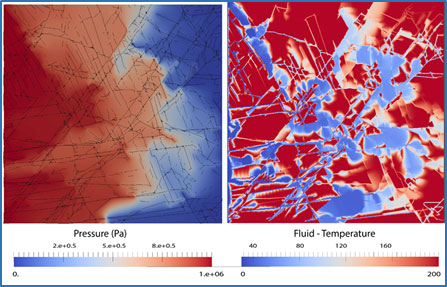
|
GEOTHERM-2 conducts cross-disciplinary research towards the development of Enhanced Geothermal Systems (EGS). EGS is a technology that will allow the heat resources residing at several kilometers depths to be exploited for electricity and heat production. At present, EGS technology is not mature; two of the key challenges are the difficulty of (1) engineering a lasting heat exchanger with appropriate properties within deep, hot, low-porosity rocks, and (2) the risk of inducing felt and potentially hazardous seismic events during the development and operation of the heat exchanger. GEOTHERM-2 continues the work initiate in the GEOTHERM-1 project (2009-2012). The project was conceived in order to provide a bridge to a major nationwide project in geothermal energy, the Swiss Competence Center Energy Research-Supply of Energy (SCCER-SoE), that was in its planning phase when GEOTHERM-2 was proposed, and has begun in the meantime. In total thirty eight co-workers from various Departments and Institutes in ETH and in EPFL, and of the Paul Scherrer Institute contribute to the project. The main strength of GEOTHERM-2 is to adopt a cross-disciplinary approach to the challenges mentioned above. The contributions of GEOTHERM-2 in terms of scientific results, capacity building and knowledge transfer are a therefore critical intermediate step towards successful future Pilot and Demonstration projects, and complement the activities conducted in SCCER-SoE. The research activities in GEOTHERM-2 are organized in six Modules or work packages, which are designed to:
|
|---|---|
| Project Leader al SED | Prof. Dr. Stefan Wiemer |
| Partecipanti del SED | Prof. Dr. Stefan Wiemer, Dr. Alba Zappone, Dr. Laurentiu Danciu, Dr. Pierre Dublanchet, Dr. Valentin Gischig, Dr. Dimitrios Karvounis, Eszter Király, Dr. Toni Kraft, Lukas Heiniger, Marcus Herrmann, Dr. Anne Obermann, Dr. Arnaud Mignan, Barbara Schechinger |
| Finanziamento | Competence Center Environment Sustainability (CCES), Competence Center Energy and Mobility (CCEM) and Bundesamt Für Energie (BFE) |
| Durata | 2013 - 2016 |
| Parole chiavi | Energy, geothermy, multidisciplinary |
| Settore di ricerca | Induced Seismicity, Geomechanics, Geochemistry, energy conversion systems, Social Acceptance |
| Link alla Website | |
| Publicazioni |
Deichmann N., Kraft T. and Evans K.F. (2014). Identification of faults activated during the stimulation of the Basel geothermal project from cluster analysis and focal mechanisms of the larger magnitude events. Geothermics 52, 84-97. doi: 10.1016/j.geothermics.2014.04.001 Driesner, T. (2013). The Molecular-Scale Fundament of Geothermal Fluid Thermodynamics. Reviews in Mineralogy and Geochemistry 76, 5-33. doi: 10.2138/rmg.2013.76.2 Gischig, V., and Wiemer, S. (2013). A stochastic model for induced seismicity based on non-linearpressure diffusion and irreversible permeability enhancement. Geophys. J. Int.. doi: 10.1093/gji/ggt164 Hillers, G., Husen, S., Obermann, A., Planès, T., Campillo, M. and Larose, E. (2015). Noise based monitoring and imaging resolve reservoir dynamics associated with the 2006 Basel injection experiment. Geophysics 80(4), 51-68. doi: 10.1190/GEO2014-0455.1 Hingerl, F.F., Kosakowski, G., Wagner, T., Kulik, D.A. and Driesner, T. (2014). GEMSFIT: a generic fitting tool for geochemical activity models. Computational Geosciences 18(2), 227-242. doi: 10.1007/s10596-014-9405-3 Hingerl, F.F., Wagner, T., Kulik, D.A., Thomsen ,K. and Driesner, T. (2014). A new aqueous activity model for geothermal brines in the system Na-K-Ca-Mg-H-Cl-SO4-H2O from 25 to 300°C. Chem. Geol. 381, 78-93. doi: 10.1016/j.chemgeo.2014.05.007 Hirschberg, S., Wiemer, S. and Burgherr, P. (2015). Energy from the earth: Deep geothermal as a resource for the future?. TA-Swiss, Bern, Switzerland, 220-251. Kaiser, P.K., Valley, B., Dusseault, M.B. and Duff, D. (2013). Hydraulic Fracturing Mine Back Trials – Design Rational and Project status. In: Bunger, A.P., McLennan, J. and Jeffrey, R. : Effective and sustainable hydraulic fracturing. InTech. doi: 10.5772/56260 Kraft, T. and Deichmann, N. (2014). High precision relocation and focal mechanism of the injection induces seismicity at the Basel EGS. Geothermics 52, 59-73. doi: 10.1016/j.geothermics.2014.05.014 Obermann, A., Kraft, T., Larose, E. and Wiemer, S. (2015). Potential of ambient seismic noise techniques to monitor reservoir dynamics at the St. Gallen geothermal site (Switzerland). JGR. doi: 10.1002/2014JB011817 Preisig, G., Eberhardt, E., Gischig, V., Roche, V., van der Baan, M., Valley, B., Kaiser, P.K., Duff, D. and Lowther, R. (2015). Development of connected permeability in massive crystalline rocks through hydraulic fracture propagation and shearing accompanying fluid injection. Geofluids 15, 321-337. doi: 10.1111/gfl.12097 Rivera, J.A., Blum, P. and Bayer, P. (2015). Analytical simulation of groundwater flow and land surface effects on thermal plumes of borehole heat exchangers. Applied Energy 146, 421-433. doi: 10.1016/j.apenergy.2015.02.035 Spada, M., Sutra, E., Wolf, S. and Burgherr, P. (2014). Accident Risk Assessment for Deep Geothermal Energy Systems. In: Nowakowski, T., Mlynczak, M., Jodejko-Pietruczuk, A. and Werbinska-Woiciechowska, S.: Safety and Reliability: Methodology and Applications. Taylor and Francis Group, London UK. Stauffacher, M., Muggli, N., Scolobig, A. and Moser, C. (2015). Framing deep geothermal energy in mass media: the case of Switzerland. Technological Forecasting and Social Change 98, 60–70. doi: 10.1016/j.techfore.2015.05.018 Weis, P., Driesner, T., Coumou, D. and Geiger, S. (2014). Hydrothermal, multiphase convection of H2O-NaCl fluids from ambient to magmatic temperatures: a new numerical scheme and benchmarks for code comparison. Geofluids 14(3), 347-371. doi: 10.1111/gfl.12080 Zezin, D., Driesner, T. and Sanchez-Valle, C. (2015). Volumetric Properties of Na2SO4–H2O and Na2SO4–NaCl–H2O Solutions to 523.15 K, 70 MPa. J. Chem. Eng. Data 60(4), 1181–1192. doi: 10.1021/je501152a Zezin, D., Driesner, T. and Sanchez-Valle, C. (2014). Volumetric Properties of Mixed Electrolyte Aqueous Solutions at Elevated Temperatures and Pressures. The System KCl–NaCl–H2O to 523.15 K, 40 MPa, and Ionic Strength from (0.1 to 5.8) mol·kg–1. Journal of Chemical and Engineering Data 59, 736-749. doi: 10.1021/je400761c |
Risk, Safety and Societal Acceptance (SCCER-SoE Task 4.1)
FASTER
Novel unconventional geothermal technologies that require hydraulic stimulation through induced seismicity, also require Forecasting and Assessing Seismicity and Thermal Evolution in geothermal Reservoirs (FASTER). This task needs to be performed in real time and both regulators and operators wish to know the probability of a future undesired large induced event in time for risk mitigation measurements to be employed. Fundamental and applied research with the ultimate goal to develop strategies and tools for managing and limiting induced seismicity is a major international focus of current research in geophysics and reservoir engineering. Moreover, predictive assessment of seismic risk in near‐real time is considered the most crucial aspect for proactive operational management of stimulation, exploitation or storage to minimize risk, avoid unacceptable seismic hazard and enhance the societal acceptance. In the FASTER project, the software framework that is currently used by SED for fundamental research on seismic risk predictions and it performs complicated 3D Monte Carlo simulations is improved, extended, and adapted to current and upcoming generations of supercomputers. The software is customized to the needs of the Adaptive Traffic Light Systems through accelerated algorithms, numerical solvers, probabilistic models and Monte Carlo integrations, and computational bottlenecks due to coding are resolved. |
|
| Project Leader al SED | Dr. Dimitrios Karvounis |
|---|---|
| Partecipanti del SED | Stefan Wiemer |
| Finanziamento | PASC |
| Durata | 10.2017-09.2020 |
| Parole chiavi | Earthquake Hazard & Risk, Real-time monitoring, Enhanced Geothermal Systems |
| Settore di ricerca | Induced Seismicity, Software Development, Probabilistic Methods, Code Optimization |
ELEGANCY
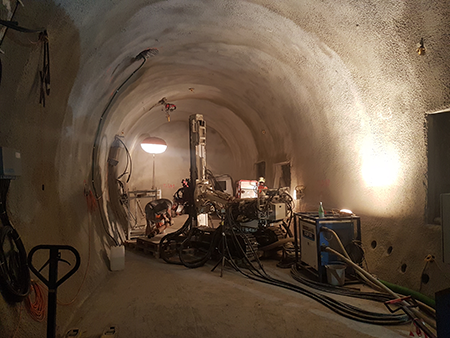
|
Storing CO2 underground (Carbon Capture and Storage CCS) is one technology among others that reduces emissions above ground and therefore supports the objectives of the Energy Strategy 2050. Once the CO2 is stored, it may escape through the borehole used to pump in the CO2 or through faults in the rock above the reservoir meant to seal it. Those faults might not only influence the long-term containment of CO2, but also the occurrence of induced micro-seismicity. The presence of faults in the capturing rock therefore strongly affects the site characterization process in terms of safety and risk assessment, monitoring, verification, and with respect to the risk management plan. To study these aspects, the Swiss Seismological Service and the SCCER-SoE conduct an experiment in close collaboration with the Department of Mechanical and Process Engineering and the Institute of Geophysics at ETH Zurich, with Swisstopo and EPFL, and with scientists from Norway, the Netherlands and the UK. The experiment is part of the ELEGANCY project, which is funded by the EU and the SFOE. The main goal of the experiment is to understand the relevant processes governing movement of stored CO2 along faults, the occurrence of micro-seismicity and to contribute to an enhanced site characterization. This involves experimental work at the Mont Terri rock laboratory, where the scientists inject CO2 enriched salt water into a borehole that cuts through a major fault and monitor how the fault reacts. |
|---|---|
| Project Leader al SED | Dr. Alba Zappone |
| Finanziamento | Elegancy is a project financed by Norwegian, Dutch, German, UK and Swiss national funding agencies, the European Commission, and industry. |
| Durata | 31 August 2017–31 August 2020 |
| Parole chiavi | Induced Seismicity, Carbon Capture and Storage |
| Settore di ricerca | Induced Seismicity, Swiss Seismicity, Earthquake Hazard & Risk, Earthquake Statistics, Earthquake Early Warning, Historical Seismicity, Seismotectonics, Real-time monitoring, Engi-neer Seismology, Other |
| Link alla Website | |
| Publicazioni |
Grab et al. (2022). Fluid pressure monitoring during hydraulic testing in faulted Opalinus Clay using seismic velocity observations. J. Geophys In print . Hopp, C., Guglielmi, Y., Rinaldi, A. P., Soom, F., Wenning, Q., Cook, P., Robertson, M., Kakurina M., Zappone A. (2021). The effect of fault architecture on slip behavior in shale revealed by distributed fiber optic strain sensing. Journal of Geophysical Research: Solid Earth. doi: 10.1002/essoar.10507120.1 Wenning Q., Madonna C., Kurotori T., Petrini C., Hwang J., Zappone A., Wiemer S., Giardini D., Pini R. (2021). Chemo-mechanical coupling in fractured shale with water and hydrocarbon flow. Geophysical Research Letters. doi: 10.1029/2020GL091357 Wenning Q., Madonna C., Zappone A., Grab M., Rinaldi A.P., Ploetze M., Nussbaum C., Giardini D., Wiemer S. (2021). Shale fault zone structure and stress dependant anisotropic permeability and seismic velocity properties (Opalinus clay, Switzerland). Journal of Structural Geology 144. doi: 10.1016/j.jsg.2020.104273 Zappone A. Rinaldi A.P., Grab M., Wenning Q., Roques C., Madonna C., Obermann A., Bernasconi S. M., Soom F., Cook P., Guglielmi Y., Nussbaum C., Giardini D., Wiemer S. (2021). Fault sealing and caprock integrity for CO2 storage: an in-situ injection experiment. Solid Earth Discussion. doi: 10.5194/se-2020-100 |
detect-µ
Monitoring Geothermieprojekt Schlattingen
At the geothermal project Schlattingen/TG a borehole was sunk to 1.2km depth and stimulated with acid in early 2013. The Swiss Seismological Service monitored the acid stimulation with borehole and surface seismometers and in this way created a highly sensitive system for the detection of smallest fracture processes. The goal of the monitoring was to better understand the fundamental processes of a chemical stimulation, and to test if the analysis of tiny earthquakes can be used for the calibration of seismic hazard models to shorten the death times of traffic light systems. By comparing downhole and surface data, the performance of the different network and the attenuation of ambient seismic noise with depth will be investigated. In the framework of the project GEOBEST the results will be used to develop guidelines for the design of seismic monitoring networks. |
|
| Project Leader al SED | Toni Kraft |
|---|---|
| Finanziamento | Bundesamt für Energie |
| Durata | 2013-2015 |
| Parole chiavi | |
| Settore di ricerca | Induced Seismicity, Real-time monitoring, reservoir stimulation techniques |
GeoBest
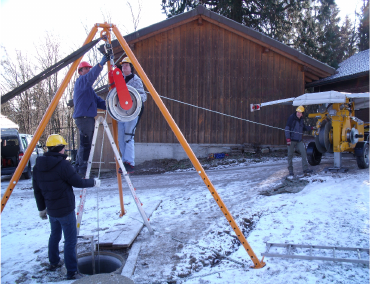
|
The processes and conditions underpinning induced seismicity associated with deep geothermal operations are still not sufficiently well understood to make useful predictions as to the likely seismic response to reservoir development and exploitation. The empirical data include only a handful of well-monitored EGS experiments; models are consequently poorly constrained. Unfortunately, datasets of well-monitored deep hydrothermal experiments are missing and empirical constraints of induced seismicity models for these cases do not exist. Given that the majority of the projects underway or planned in Europe are of the hydrothermal type, there is hope that this deficit can be remedied in the near future through a close cooperation of geothermal industry, science and public authorities. This is where the GeoBest project comes to play. By supporting selected pilot project for a limited time, SED facilitates the dialog with geothermal industry. Besides of the unique opportunity to collect high quality seismic data and being able to access relevant project data, gaining first hand practical experience in this field is of paramour importance for the development of significant best practice guidlines. |
|---|---|
| Project Leader al SED | Toni Kraft |
| Partecipanti del SED | INDU group |
| Finanziamento | Bundesamt für Energie |
| Durata | 2011-2015 |
| Parole chiavi | Enhanced Geothermal System (EGS); Induced seismicity; High-precision hypocenter locations; Activated faults |
| Settore di ricerca | Induced Seismicity, Earthquake Statistics, Seismotectonics, Real-time monitoring |
| Publicazioni |
Deichmann, N., Kraft, T. and Evans, K.F. (2014). Identification of faults activated during the stimulation of the Basel geothermal project from cluster analysis and focal mechanisms of the larger magnitude events. Geothermics 52, 84-97. doi: 10.1016/j.geothermics.2014.04.001 Diehl, T., Kraft, T., Kissling, E., Deichmann, N., Clinton, J. and Wiemer, S. (2014). High-precision relocation of induced seismicity in the geothermal system below St. Gallen (Switzerland). EGU General Assembly Conference Abstracts 16, 12541. Edwards, B., Kraft, T., Cauzzi, C., Kastli, P. and Wiemer, S. (2015). Seismic monitoring and analysis of deep geothermal projects in St Gallen and Basel, Switzerland. Geophys. J. Int. 201, 1020-1037. Evans, K.F., Zappone, A., Kraft, T., Deichmann, N. and Moia, F. (2012). A survey of the induced seismic responses to fluid injection in geothermal and CO2 reservoirs in Europe. Geothermics 41, 30-54. doi: 10.1016/j.geothermics.2011.08.002 Goertz, A., Riahi, N., Kraft, T. and Lambert, M. (2012). Modeling Detection Thresholds of Microseismic Monitoring Networks. 2012 SEG Annual Meeting. Society of Exploration Geophysicists. Kraft, T., Mignan, A. and Giardini, D. (2013). Optimization of a large-scale microseismic monitoring network in northern Switzerland. Geophysical Journal International 195, 474-490. doi: 10.1093/gji/ggt225 Kraft, T., Wiemer, S., Deichmann, N., Diehl, T., Edwards, B., Guilhem, A., Haslinger, F. et al. (2013). The ML 3.5 earthquake sequence induced by the hydrothermal energy project in St. Gallen, Switzerland. AGU Fall Meeting Abstracts 1, 3. Kraft, T. and Deichmann, N. (2014). High-precision relocation and focal mechanism of the injection-induced seismicity at the Basel EGS. Geothermics 52, 59-73. doi: 10.1016/j.geothermics.2014.05.014 Kraft, T. (2015). A high-resolution ambient seismic noise model for Europe. EGU General Assembly Conference Abstracts 16, 12407. Kraft, T. et al. (2015). Lessons learned from the 2013 ML3.5 induced earthquake sequence at the St. Gallen geothermal site. Schatzalp Workshop on Induced Seismicity, Davos, Switzerland. Obermann, A., Kraft, T., Larose, E. and Wiemer, S. (2015). Potential of ambient seismic noise techniques to monitor the St. Gallen geothermal site (Switzerland). J. Geophys. Res. Solid Earth 120(6), 4301–4316. doi: 10.1002/2014JB011817 Plenkers, K., Husen, S. and Kraft, T. (2015). A Multi-Step Assessment Scheme for Seismic Network Site Selection in Densely Populated Areas. Journal of Seismology 19(4), 861-879. |
GEOBEST

|
Negli ultimi anni il SED ha accompagnato con la sua attività di monitoraggio sismico diversi progetti svizzeri di geotermia di profondità, avviando un dialogo costruttivo con i vari gestori e le autorità cantonali. Sulla base dell’esperienza maturata, il SED ha sviluppato le prime raccomandazioni – rivolte alle autorità cantonali di autorizzazione ed esecuzione – su come gestire la problematica delle sismicità indotta nelle varie fasi di un progetto di geotermia di profondità. Finora queste raccomandazioni si basano però sulle esperienze derivanti da solo pochi progetti ben documentati. Oggi in Svizzera manca ancora l’esperienza pratica con la loro attuazione. È quindi difficile valutare se queste esperienze siano applicabili al contesto locale (geologico, politico, culturale) e quali modifiche si rendano eventualmente necessarie. Un’altra questione importante in questo contesto è valutare in che modo direttive e norme provenienti da altri settori tecnici e ufficiali interagiscono e sono compatibili con le raccomandazioni sismologiche per evitare la sismicità indotta. Spesso i possibili conflitti possono essere individuati e risolti solo durante la messa in pratica del progetto e grazie alla stretta collaborazione dei sismologi con le autorità che rilasciano le autorizzazioni, così come con i gestori degli impianti. Altrettanto importante è il controllo e l’adeguamento periodico di tutte le direttive e norme essenziali sulla base dello stato delle conoscenze acquisito. Quando possibile, ciò dovrebbe avvenire con il consenso di tutti i gruppi di interessati. Nel corso del progetto Geobest, il SED continuerà quindi a raccogliere, valutare e interpretare gli insiemi di dati di alta qualità e risoluzione sull’origine della sismicità indotta durante i progetti di geotermia di profondità. In questo modo, il SED potrà inoltre offrire un servizio di consulenza e supporto sismologico alle autorità cantonali e federali durante le loro attività di autorizzazione e monitoraggio in tutte le fasi di un progetto di geotermia di profondità. Il SED intende in questo modo contribuire a creare criteri di valutazione standard per l’impatto ambientale che vadano al di là dei limiti cantonali, permettendo così un’uniformazione a breve e a medio termine e quindi un notevole snellimento e accelerazione di questo processo. Un sito web centrale farà in modo che l’opinione pubblica venga informata in modo indipendente, attuale e competente sul tema della sismicità indotta al fine di favorire una discussione oggettiva tra tutti gli interessati. |
|---|---|
| Project Leader al SED | Toni Kraft |
| Partecipanti del SED | Philippe Roth, Stefan Wiemer |
| Finanziamento | |
| Durata | 2015-2019 |
| Parole chiavi | Induced Seismicity, Induced Earthquake Hazard & Risk, Real-time monitoring, Support and consultancy |
| Settore di ricerca | Induced Seismicity, Induced Earthquake Hazard & Risk, Real-time monitoring, Support and consultancy |
| Link alla Website | |
| Publicazioni | |
| Reports / Risultati |
Zbinden, D., Rinaldi, A. P., Diehl, T., & Wiemer, S. (2020). Potential influence of overpressurized gas on the induced seismicity in the St. Gallen deep geothermal project (Switzerland).. Solid Earth 11 (3), 909-933. doi: 10.5194/se-11-909-2020 Zbinden, D., Rinaldi, A. P., Diehl, T., & Wiemer, S. (2020). Hydromechanical Modeling of Fault Reactivation in the St. Gallen Deep Geothermal Project (Switzerland): Poroelasticity or Hydraulic Connection?. Geophysical Research Letters 47(3). e2019GL085201. doi: 10.1029/2019GL085201 Király‐Proag, E., Satriano, C., Bernard, P., & Wiemer, S. (2019). Rupture Process of the M w 3.3 Earthquake in the St. Gallen 2013 Geothermal Reservoir, Switzerland.. Geophysical Research Letters 46(14), 7990-7999. doi: 10.1029/2019GL082911 Kraft, T. & S. Wiemer (2019). GEOBEST-CH2 - Zwischenbericht II. Bericht des Schweizerischen Erdbebendienstes zu Händen des Bundesamtes für Energie, November 2018. Kraft, T. & S. Wiemer (2018). GEOBEST-CH2 - Zwischenbericht II. Bericht des Schweizerischen Erdbebendienstes zu Händen des Bundesamtes für Energie, November 2018. . Kraft, T. & S. Wiemer (2017). GEOBEST-CH2 - Zwischenbericht I. Bericht des Schweizerischen Erdbebendienstes zu Händen des Bundesamtes für Energie, Dezember 2017. Kraft, T. & S. Wiemer (2017). GEOBEST-CH - Abschlussbereicht. Bericht des Schweizerischen Erdbebendienstes zu Händen des Bundesamtes für Energie, Oktober 2017. https://www.research-collection.ethz.ch/handle/20.500.11850/426644 Wiemer, S., Kraft, T., Trutnevyte, E. and Philippe Roth (2017). “Good Practice” Guide for Managing Induced Seismicity in Deep Geothermal Energy Projects in Switzerland. Swiss Seismological Service at ETH Zurich. doi: 10.12686/a5 Kraft, T. & S. Wiemer (2016). GEOBEST-CH - Zwischenbericht II. Bericht des Schweizerischen Erdbebendienstes zu Händen des Bundesamtes für Energie, Dezember 2016. Kraft, T. & S. Wiemer (2015). GEOBEST-CH - Zwischenbericht I. Bericht des Schweizerischen Erdbebendienstes zu Händen des Bundesamtes für Energie, Dezember 2015. Kraft, T. & S. Wiemer (2015). Abschlussbericht, Projekt GEOBEST, Berichtszeitraum Okt. 2011 – Nov. 2015. Bericht des Schweizerischen Erdbebendienstes zu Händen des Bundesamtes für Energie, Dezember 2015. Link Kraft, T. & S. Wiemer (2015). Zwischenbericht IV, Projekt GEOBEST, Bericht des Schweizerischen Erdbebendienstes zu Händen des Bundesamtes für Energie, Dezember 2015. Kraft, T. & S. Wiemer (2014). Zwischenbericht III, Projekt GEOBEST, Bericht des Schweizerischen Erdbebendienstes zu Händen des Bundesamtes für Energie, November 2014. Kraft, T. & S. Wiemer (2012). Zwischenbericht II, Projekt GEOBEST, Bericht des Schweizerischen Erdbebendienstes zu Händen des Bundesamtes für Energie, September 2012. Kraft, T. & S. Wiemer (2011). Zwischenbericht I, Projekt GEOBEST, Bericht des Schweizerischen Erdbebendienstes zu Händen des Bundesamtes für Energie, August 2011. |
Noville Network
The Noville network is operated under a contract with Petrosvibri SA. The purpose of the network is to monitor induced seismicity related to a deep gas exploration drilling project near Noville, VD. |
|
| Project Leader al SED | Stephan Husen |
|---|---|
| Partecipanti del SED | Toni Kraft |
| Finanziamento | |
| Durata | 2009-2012 |
| Parole chiavi | Induced Seismicity, Real-time monitoring, Engineer Seismology |
| Settore di ricerca | Induced Seismicity, Real-time monitoring, Engineer Seismology |
Brigerbad Network
The Brigerbad network is operated under a contract with Geothermie Brigerbad AG. The purpose of the network is to monitor induced seismicity related to the extraction of hot thermal waters from 400-600 m deep boreholes in Brigerbad, VS. |
|
| Project Leader al SED | Stephan Husen |
|---|---|
| Partecipanti del SED | Toni Kraft |
| Finanziamento | Geothermie Brigerbad AG |
| Durata | 2009-2011 |
| Parole chiavi | Geothermie Brigerbad AG |
| Settore di ricerca | Induced Seismicity, Real-time monitoring |
Sismologia storica
Interdisciplinary Assessment of the Pre-instrumental and Early Instrumental Period of Systematic Earthquake Monitoring
Lake sediments as archive of paleoearthquakes in Switzerland
Historical Seismology 1912-1963: Ensuring the sustainability of interdisciplinary historical earthquake research at the SED
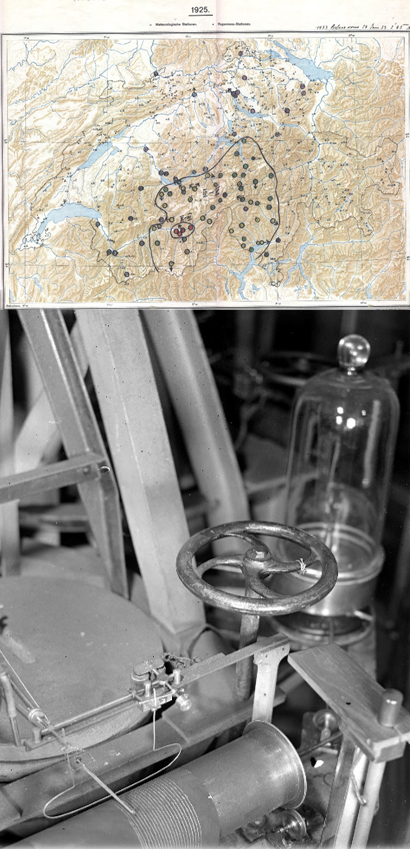
|
The assessment of seismic hazard in regions such as Switzerland are mainly based on historical documents due to the long return periods of medium to large earthquakes. During the last 20 years, seismologists, historians and database experts at the Swiss Seismological Service (SED) at ETH Zurich have been working together on a number of successful interdisciplinary projects. Within the framework of projects supported by the Swiss National Science Foundation, a wealth of data has been compiled covering information for the pre- and early instrumental period of scientific earthquake monitoring (1880-1963) . The compiled material consists of information collected using very different methods and covers both descriptive and early instrumental data. Due to the wealth of data and the challenges involved in recording and digitizing the very different types of sources, the potential of this data stock has not yet been exploited beyond the basic documentation and interpretation. This follow-up project, funded by the cogito foundation, serves to maintain the sustainability of the interdisciplinary historical research at the SED through in-depth and systematic analysis, documentation and publication activities. In the seismological domain, the improvement and interconnection of the macroseismic and instrumental data play an important role for the next revision of the earthquake catalogue of Switzerland. In the field of history of knowledge, the development of the SED in the first half of the 20th century can also be used as a data-supported historical case study on the conceptual, organizational and technological development of a scientific institution and its practices |
|---|---|
| Project Leader al SED | Prof. Donat Fäh |
| Partecipanti del SED | Remo Grolimund |
| Finanziamento | |
| Durata | 2020 - 2021 |
| Parole chiavi | Historical Seismology, Interdisciplinary, Historical Seismogram Analysis, Macroseismics, History of Science and Technology |
| Settore di ricerca | Swiss Seismicity, Earthquake Hazard & Risk, Historical Seismicity |
Sismologia ingegneristica
4D seismic response and slope failure
Nagra Station Characterization
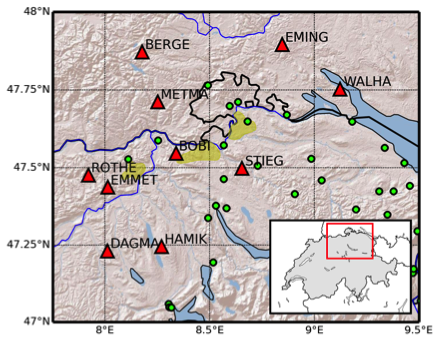
|
In cooperation with the National Cooperative for the Disposal of Radioactive Waste (Nagra), the Swiss Seismological Service has recently completed the installation of ten new seismological observation stations, three of them including a co-located borehole sensor. The ultimate goal of the project is to densify the existing Swiss Digital Seismic Network (SDSNet) in Northern Switzerland, in order to increase the sensitivity to very-low magnitude events and to improve the accuracy of future location solutions. This is strategic for unbiased monitoring of micro-seismicity at the places of proposed nuclear waste repositories. At each site, to further improve the quality and usability of the recordings, a full seismic characterization of the area surrounding the installation area was performed. The investigation consisted of a preliminary geological and geotechnical study, followed by an accurate seismic site response analysis by means of state-of-art geophysical techniques. For the borehole stations, in particular, the characterization was performed by combining different types of active seismic methods (refraction tomography, surface wave analysis, Vertical Seismic Profiling, VSP) with ambient vibration based approaches (wavelet decomposition, H/V spectral ratio, polarization analysis, three component f-k analysis). Results converged to the definition a unique summary velocity profile for the site, later used for the computation of the analytical SH-wave amplification function |
|---|---|
| Project Leader al SED | Donat Fäh |
| Partecipanti del SED | Valerio Poggi |
| Finanziamento | Nagra |
| Durata | 2012-2015 |
| Parole chiavi | Site characterization, seismic stations |
| Settore di ricerca | Applied and engineering seismology |
| Publicazioni |
Poggi, V., Keller, L. and Fäh, D. (2014). The new broadband seismic network in Northern Switzerland: Site characterization. Nagra Arbeitsbericht NAB, 15-54. Dal Moro, G., Keller, L. and Poggi, V. (2015). A comprehensive seismic characterisation via multi-component analysis of active and passive data. First Break 33(9), 45-53. |
| Reports / Risultati |
Earthquake Physics Group
By means of theoretical and computational modeling, the research in Earthquake Physics Group aimed to cover the entire process of earthquakes: its source, radiation path, and ground motion at the surface. We performed both fundamental research on earthquake rupture dynamic processes and wave propagation and apply it for the development of physics-based models for ground motion prediction, seismic hazard assessment and earthquake engineering applications. Our main goal was to acquire a better understanding in the physics and mechanics of earthquakes. The research topics were:
Development of physics-based Ground Motion Prediction Equation Models (GMPE) |
|
| Project Leader al SED | Luis A. Dalguer |
|---|---|
| Partecipanti del SED | Cyrill Baumann Alice Gabriel Percy Galvez Walter Imperatori Banu Mena Cabrera Seok Goo Song Ylona van Dinther Youbing Zhang |
| Finanziamento | SNF CSCS, CCES-ETH, SCEC, Volksbankstiftung, 7th Framework Program of the European Commission |
| Durata | 2009-2014 |
| Parole chiavi | Earthquake rupture dynamic, ground motion modeling, numerical simulation, friction models, earthquake cycles. |
| Settore di ricerca | Physics of earthquake, Earthquake seismology, engineering seismology, High Performance Computing |
| Publicazioni |
Galvez, P., Dalguer, L.A., Ampuero, J.P. and Giardini, D. (2016). Slip reactivation during the 2011 Mw 9.0 Tohoku earthquake: Dynamic rupture and ground motion simulations. Bull. Seismol. Soc. Am., In press. Zhang, Y., Dalguer, L.A., Song, S.G., Clinton, J. and Giardini, D. (2015). Evaluating the effect of network density and geometric distribution on kinematic source inversion models. Geophys. J. Int. 200, 1-6. doi: 10.1093/gji/ggu252 Herrendoerfer, R., van Dinther, Y., Gerya, T.V. and Dalguer, L.A. (2015). Seismogenic zone downdip width controls supercycles at subduction thrusts. Nature Geoscience 8, 471–474. doi: 10.1038/ngeo2427 Galvez, P., Ampuero, J.P., Dalguer, L.A., Somala, S.N. and Nissen-Meyer, T. (2014). Dynamic earthquake rupture modeled with an unstructured 3D spectral element method applied to the 2011 M9 Toholu earthquake. Geophys. J. Int. 198, 1222–1240. doi: 10.1093/gji/ggu203 Baumann, C. and Dalguer, L.A. (2014). Evaluating the Compatibility of Dynamic-Rupture-Based Synthetic Ground Motion with Empirical GMPE. Bull. Seismol. Soc. Am. 104(2). doi: 10.1785/0120130077 van Dinther, Y., Gerya, T.V., Dalguer, L.A. and Mai, P.M. (2014). Modeling the seismic cycle in subduction zones: the role and spatiotemporal occurrence of off-megathrust earthquakes. Geophysical Research Letters 41(4), 1194–1201. Song, S.G., Dalguer, L.A. and Mai, P.M. (2013). Pseudo-dynamic source modeling with 1-point and 2-point statistics of earthquake source parameters. Geophys. J. Int. 196(3), 1770-1786. doi: 10.1093/gji/ggt479 Causse, M., Dalguer, L. A. and Mai, P.M. (2013). Variability of Dynamic Source Parameters Inferred from Kinematic Models of Past Earthquakes. Geophys. J. Int. 196(3), 1754-1769. doi: 10.1093/gji/ggt478 van Dinther, Y., Gerya, T.V., Dalguer, L.A., Mai, P.M., Morra, G. and Giardini, D. (2013). The seismic cycle at subduction thrusts: insights from seismo-thermo-mechanical models. J. Geophys. Res. Solid Earth 118(12), 6183–6202. doi: 10.1002/2013JB010380 Baumann, C., Burjanek, J., Michel, C., Haeh, D. and Dalguer, L.A. (2013). Fault zone signatures from ambient vibration measurements: a case study in the region of Visp (Valais, Switzerland). Swiss J. Geosci. 106, 529-541. doi: 10.1007/s00015-013-0155-3 Gabriel, A.A., Ampuero, J.P., Dalguer, L.A. and Mai, P.M. (2013). Source Properties of Dynamic Rupture Pulses with Off-Fault Plasticity. J. Geophys. Res. 118(8), 4117–4126. doi: 10.1002/jgrb.50213 Song, S.G. and Dalguer, L.A. (2013). Importance of 1-point statistics in earthquake source modeling for ground motion simulation. Geophys. J. Int. 192(3), 1255-1270. doi: 10.1093/gji/ggs089 van Dinther, Y, Gerya, T.V., Dalguer, L. A., Corbi, F., Funiciello, F. and Mai, P.M. (2013). The seismic cycle at subduction thrusts: 2. Dynamic implications of geodynamic simulations benchmarked with laboratory models. J. Geophys. Res. 118(4), 1502–1525. doi: 10.1029/2012JB009479 Mikhailov, V., Lyakhovsky, V., Panet, I., van Dinther, Y., Diament, M., Gerya, T.V., deViron, O. and Timoshkina, E. (2013). Numerical modelling of post-seismic rupture propagation after the Sumatra 26.12.2004 earthquake constrained by GRACE gravity data. Geophysical Journal International 194(2), 640-650. doi: 10.1093/gji/ggt145 Corbi, F., Funiciello, F., Moroni, M., van Dinther, Y., Mai, P.M., Dalguer, L.A. and Faccenna, C. (2012). The seismic cycle at subduction thrusts: 1. insights from laboratory models. J. Geophys. Res. 118(4), 1483–1501. doi: 10.1029/2012JB009481 |
Characterization of potential earthquake-triggered rock slope failures through ambient vibration analysis
In this ETHZ-funded project we analyze ambient vibrations and earthquake recordings to characterize and investigate the dynamic response of unstable rock slopes. We perform systematic measurements and interpretation of ambient vibrations at known unstable rock slopes, both with single stations and array-configurations. The eigenfrequencies, eigenmodes, directivity, and amplification of ambient vibrations are identified and compared to geotechnical investigations. The interpretation of recordings targets the estimation of the potential landslide volume and is supported by numerical modeling of seismic wave propagation in fractured media. A classification scheme based on the seismic response has been introduced, in which each class indicates specific properties of a rock instability. The two main classes found are volume-controlled sites and depth-controlled sites. The extensive database will be extended with instabilities on high-alpine permafrost locations. Moreover, both short-term and long-term monitoring is undertaken to understand the time evolution of the slope structure. Temporary monitoring stations are installed at the rock slope instabilities of Preonzo (Ticino) and Brienz (Grisons) and on a high-alpine permafrost ridge close to Gemsstock (Uri). A main goal of this monitoring is to understand the effect of weather and climate on the dynamic behavior of the rock and its stability, and to measure the slopes’ seismic response to earthquake ground motion. In a later stage of the project, the effect of earthquakes on the rock slope stability will be evaluated using numerical modelling. It will be evaluated, if ambient noise measurements can provide a direct proxy for the seismic vulnerability of rock slope instabilities. The expected results have the potential to be applied directly in hazard analysis and risk reduction measures. |
|
| Project Leader al SED | Donat Fäh |
|---|---|
| Partecipanti del SED | Mauro Häusler |
| Finanziamento | ETHZ |
| Durata | 2013–2021 |
| Parole chiavi | Unstable rock slopes, ambient vibrations, ground motion modelling, landslides |
| Settore di ricerca | Seismic hazard, earthquake induced effects, engineering seismology, slope stability |
| Publicazioni |
|
Advanced Single Station and Array Methods for the Analysis of Ambient Vibrations and Earthquake Recordings
CTI Hydrocarbon Reservoir Detection by Interpretation of Microtremor Wavefields on Large Arrays
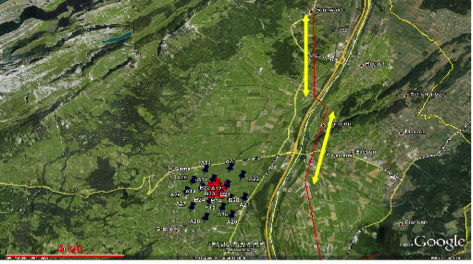
|
Hydrocarbon-bearing geological structures might cause characteristic modifications of the ambient vibration background noise. This question is addressed in a project supported by the Commission for Technology and Innovation (CTI) together with the company SpectraSeis. The link between observations and geological structure can only be made by understanding the wavefield that is recorded. This requires the simultaneous recording and analysis of ambient vibration wave-fields on arrays. Such methods have been developed in the past, and they have been applied to study soft-sediment surface deposits for seismic hazard analysis. The analysis of all three components of ground motion is addressed. Analysis of such recordings targets to distinguish between standing waves (global resonances) and propagating surface waves (Love- and Rayleigh-waves) as well as body waves (SH and PSV). By adapting array configurations during the measurements in the field, the identification of the wave-types with the corresponding propagation velocity and direction is optimized and allows to determine the source region of the waves and their possible origin. From the wave characteristics, structural information can be inverted that allows to improve structural models. The development of a real-time system for array measurements is part of the project. |
|---|---|
| Project Leader al SED | Donat Fäh |
| Partecipanti del SED | Stefano Maranò, Javier Revilla |
| Finanziamento | Commission for Technology and Innovation (CTI) |
| Durata | 2009-2012 |
| Parole chiavi | Array methods, ambient vibration, hydrocarbon reservoir detection |
| Settore di ricerca | Strong-motion interpretation and site-effects, Signal Processing |
| Publicazioni |
Maranò, S., Reller, C., Fäh, D. and Loeliger, H.-A. (2011). Seismic waves estimation and wave field decomposition with factor graphs. Proc. IEEE Int. Conf. Acoustics, Speech, and Signal Processing, 2748–2751. Prague, Czech Republic: IEEE. doi: 10.1109/ICASSP.2011.5947054 Reller, C., Loeliger, H.-A. and Maranò, S. (2011). Multi-sensor estimation and detection of phase-locked sinusoids. Proc. IEEE Int. Conf. Acoustics, Speech, and Signal Processing, 3872–3875. Prague, Czech Republic: IEEE. doi: 10.1109/ICASSP.2011.5947197 Maranò, S., Reller, C., Loeliger, H.-A. and Fäh, D. (2012). Seismic waves estimation and wave field decomposition: Application to ambient vibrations. Geophys. J. Int. 191, 175–188. doi: 10.1111/j.1365-246X.2012.05593.x Maranò, S. and Fäh, D. (2013). Processing of Translational and Rotational Motions of Surface Waves: Performance Analysis and Applications to Single Sensor and to Array Measurements. Geophys. J. Int. 196, 317-339. doi: 10.1093/gji/ggt18 Maranò, S., Fäh, D. and Lu, Y.M. (2014). Sensor placement for the analysis of seismic surface waves: sources of error, design criterion and array design algorithms. Geophys. J. Int. 197(3), 1566–1581. doi: 10.1093/gji/ggt489 |
| Presentazioni |
S. Maranò Seismic wave field decomposition application to the analysis of ambient vibrations. European Seismological Commission 32nd Assembly, September 6-10 2010, Montpellier, France. S. Maranò Seismic Waves Estimation and Wave Field Decomposition With Factor Graphs. IEEE International Conference on Acoustics, Speech, and Signal Processing, May 22-27 2011, Prague, Czech Republic. S. Maranò Maximum likelihood parameter estimation for surface waves: application to ambient vibrations. 4th International IASPEI/IAEE Symposium on the Effects of Surface Geology on Seismic Motion, August 23-26 2011, Santa Barbara, California. S. Maranò Maximum Likelihood wavefield parameters estimation: Application to the analysis of ambient vibrations. European Seismological Commission 33rd Assembly, August 19-24 2012, Moscow, Russia. S. Maranò Joint processing of translational and rotational motions of seismic surface waves: Performance analysis and applications. IASPEI Assembly, July 12-26 2013, Gothenburg, Sweden. Invited presentation. S. Maranò Analysis of ambient vibrations using a maximum likelihood method. European Seismological Commission 34th Assembly, August 24-29 2014, Istanbul, Turkey. |
SNF 2011 Source and Site-effect Studies for Probabilistic Seismic Hazard Assessment in Switzerland
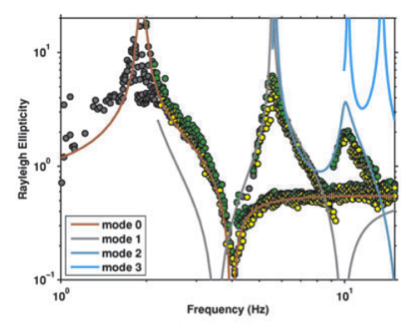
|
The project includes the work of two PhD candidates, addressing practical problems related to source characterization (Falko Bethmann) and site-effect assessment (Valerio Poggi). In the first part of this PhD project, scaling relations between small and large earthquakes are developed and the potential impact of such relations on estimating maximum near-fault ground motions is studied. In the second part of the project, new techniques for site characterization and site response analysis are implemented. First, a new method to analyze three component array recordings of ambient vibration is developed that allows retrieving the ellipticity functions of the different Rayleigh-wave modes. Subsequently, a procedure to combine passive (ambient vibration) and active-source techniques is proposed, with the goal to improve resolution of array measurements on shallow layers from high frequency component of the wave-field. Finally, generic amplification functions are developed for a common reference condition in Switzerland that serve as input for site-specific seismic hazard assessment. |
|---|---|
| Project Leader al SED | Donat Fäh |
| Partecipanti del SED | Valerio Poggi, Falko Bethmann, Nico Deichmann |
| Finanziamento | SNF |
| Durata | 2006-2010 |
| Parole chiavi | Seismic source characterization, site-effects |
| Settore di ricerca | Applied and engineering seismology |
| Publicazioni |
Poggi, V. and Fäh, D. (2010). Estimating Rayleigh wave particle motion from three-component array analysis of ambient vibrations. Geophys. J. Int. 180(1), 251-267. doi: 10.1111/j.1365-246X.2009.04402.x Poggi, V., Edwards, B. and Fäh, D. (2011). Derivation of a Reference Shear-Wave Velocity Model from Empirical Site Amplification. Bull. Seim. Soc. Am. 101(1), 258-274. doi: 10.1785/0120100060 Poggi, V., Fäh, D. and Giardini, D. (2012). T-f-k analysis of surface waves using the continuous wavelet transform. Pure and Applied Geophysics 170(3), 319-335. Poggi, V., Fäh, D., Burjanek, J. and Giardini, D. (2012). The use of Rayleigh wave ellipticity for site-specific hazard assessment and microzonation. An application to the city of Luzern (Switzerland). Geophys. J. Int. 188(3), 1154-1172. doi: 10.1111/j.1365-246X.2011.05305.x |
Renewal of the Swiss Strong Motion Network (SSMNet) – Phase 2
Spektrum – an ETH spin-off project
Earthquake-induced Phenomena
Automatic Avalanche, Landslide and Rockfall Detection in the Swiss Alps Based on their Seismic Signatures
TSUNAMI-CH Phase 2: Including delta failures and subaerial mass movements in the workflow for assessing the lake tsunami hazard
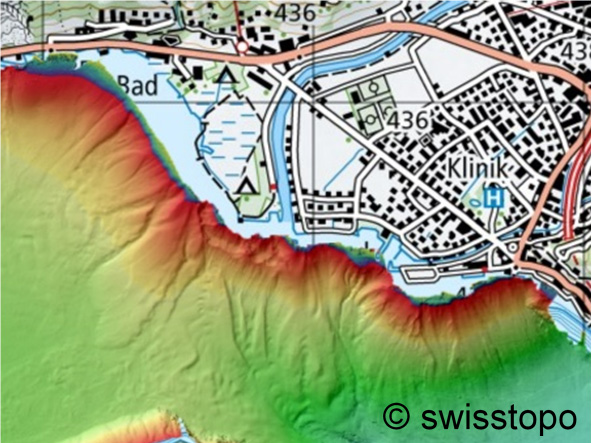
|
Tsunamis do not only happen in oceans, but they do also occur in lakes. As part of an interdisciplinary project entitled “Lake Tsunamis: Causes, Consequences and Hazard” (2017-2021), a workflow for the assessment of the tsunami potential on peri-alpine lakes was developed. The workflow focuses on the tsunami generation by subaqueous mass movements. However, it has been documented that delta failures have caused considerable tsunamis on peri-alpine lakes. So far, delta failures have been widely neglected in the assessment of lake tsunamis; mainly as the triggering and failure mechanisms have not been investigated in detail, and as important parameters such as the thickness and failure volumes are not known. WP delta will characterize various deltas in Swiss peri-alpine lakes, and identify the ones that are susceptible to failure. The resulting geodatabase will store various delta parameters that are relevant for estimating the tsunami potential. WP wave simulation extends the workflow for the modelling of the tsunami generation, propagation and inundation that was developed in the preceding project. Numerical modelling is conducted with BASEMENT, a freeware simulation tool for hydro- and morphodynamic modelling developed at VAW. WP Synthesis will document the comprehensive workflow for the assessment of the tsunami hazard. |
|---|---|
| Project Leader al SED | Michael Strupler, Stefan Wiemer |
| Partecipanti del SED | Michael Strupler, Stefan Wiemer |
| Finanziamento | Federal Office for the Environment FOEN |
| Durata | 2022-2023 |
| Parole chiavi | Lake tsunami, delta failures, subaerial mass movements, Tsunami hazard, Swiss Lakes, FOEN |
| Settore di ricerca | Earthquake Hazard & Risk |
| Link alla Website |
Sismologia statistica
Calibrating an Indicative Stress-meter for the Earth’s Crust
Database for design-compatible waveforms
In the frame of the project Database for design-compatible waveforms, we determine the magnitude-distance scenarios most relevant for the five seismic zones (Z1a, Z1b, Z2, Z3a and Z3b) defined in the Swiss building code SIA261 (2020) through disaggregating of the seismic hazard for return periods of 475 and 975 years. We inspect available worldwide databases of waveforms and related metadata, and define standards linked to the quality of three-component recordings (compatibility to GMPE, adequate frequency content, absence of non-physical drift in velocity and displacement) and quality of metadata (reliability of magnitude, distance, site condition information, free-field recording, etc.). Finally, following rules in Eurocode8, we select and scale waveforms for the different soil classes defined in the Swiss building code and each seismic zone. |
|
| Project Leader al SED | Prof. Donat Fäh |
|---|---|
| Partecipanti del SED | Paolo Bergamo, Danciu Laurenciu, Francesco Panzera |
| Finanziamento | Federal Office for the Environment (FOEN) |
| Durata | Start 1.9.2020 (3 years) |
| Parole chiavi | Seismic hazard disaggregation; response spectra; building code SIA261; strong motion waveforms |
| Settore di ricerca | Engineering Seismology |
| Publicazioni |
|
